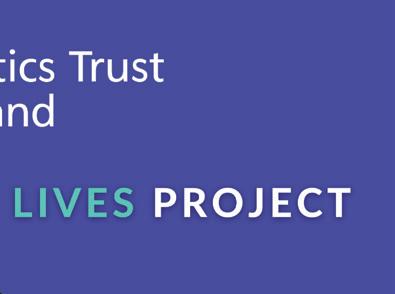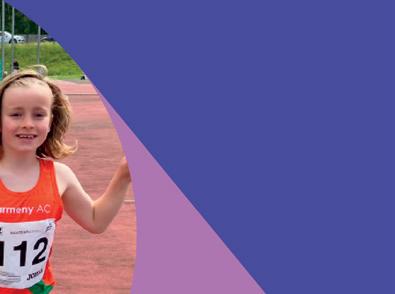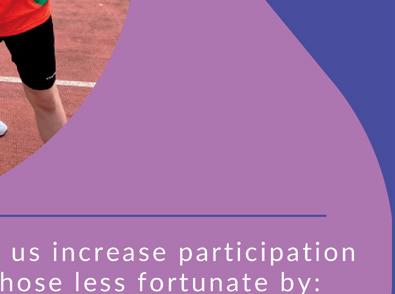
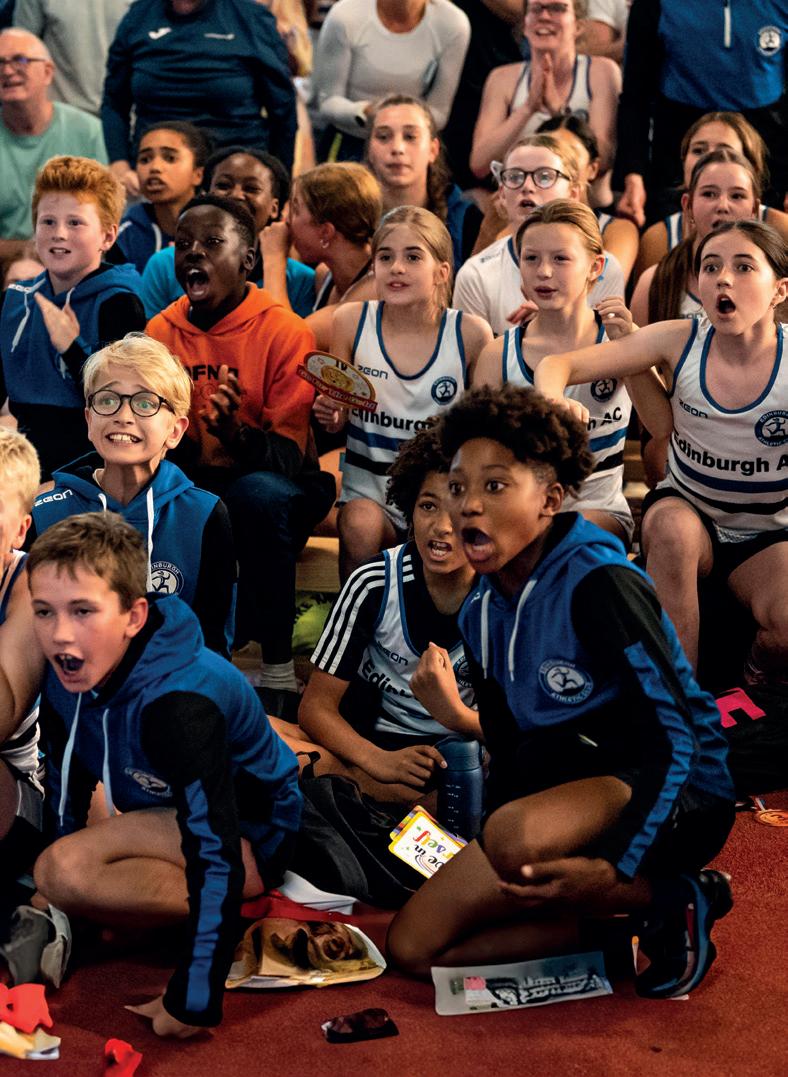



























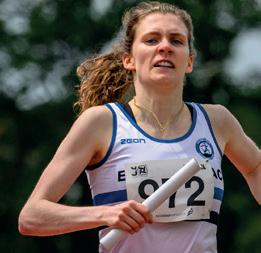
Nicole
Jemma
Laura
Nick
Sammi

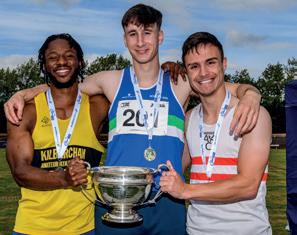




Photos: Bobby Gavin, Mark Shearman, British Athletics/Getty Images, Paralympics GB, Imagecomms, Team GB
Contributors: Colin Hutchison, Katy Barden, David Ovens, John Lenehan, Morven Bruce, Arnold Black
Advertisers: Lindsays, Joma, Athletics Trust Scotland, Glasgow Life, Project: Physio
Interviewees: Sarah Calvert, Joanna Robertson, Laura Muir, Josh Kerr, Jemma Reekie, Nick Percy, Neil Gourley, Eilish McColgan,
Megan Keith, Nicole Yeargin, Samantha Kinghorn, Ben Sandilands, Melanie Woods, Andy Munro, Elaine Mackay, Kirsty O’Brien, Liz McColgan, Luke Davidson, Malcolm Hughes, Owen Wiliams, Daniel Scroop
Clubs: Edinburgh AC, Giffnock North AC, Shettleston Harriers, Cambuslang Harriers, Garscube Harriers
FRONT COVER PHOTOS: Josh Kerr and Nicole Yeargin courtesy of British Athletics/Getty Images; Samantha Kinghorn and Ben Sandilands courtesy of Paralympics GB CONTENTS PAGE PHOTO: Young athletes embrace after friendly competition during Scottish Championships at Grangemouth (photo by Bobby Gavin)
07885 868164
Alasdhair Love Head of Competitions 07584 146 796 alasdhair.love@scottishathletics.org.uk
Allan Scott National Manager Sprints, Hurdles & Relays 07824 015 392 allan.scott@scottishathletics.org.uk
Carol Robison Membership Administrator 07391 845 783 membership@scottishathletics.org.uk
Colin Hutchison Chief Executive 07983 080 925 colin.hutchison@scottishathletics.org.uk
Dawn Allan Head of Operations 07983 080 922 dawn.allan@scottishathletics.org.uk
Lindsay McMahon National Club Manager 07918 796 648 lindsay.mcmahon@scottishathletics.org.uk
Mark Pollard Head of Performance 07584 102 980 mark.pollard@scottishathletics.org.uk
Peter Jardine Head of Communications 07885 868 164 peter.jardine@scottishathletics.org.uk
Allan Hamilton National Talent Manager 07597 577 915 allan.hamilton@scottishathletics.org.uk
Sam O’Kane National Field & Combined Events Manager 07743 928 626 sam.okane@scottishathletics.org.uk
Pamela Robson Para Pathway Manager 07827 343 410 pamela.robson@scottishathletics.org.uk
Robert Hawkins National Endurance Manager (Olympic Pathway) 07903 179 875 robert.hawkins@scottishathletics.org.uk
Shona Malcolm-Martin Of cials Development Of cer 07731 832 567 shonamalcolm@scottishathletics.org.uk
Morva McKenzie Welfare Of cer 07983 081 122 morva.mckenzie@scottishathletics.org.uk
David Fallon Head of Development 07960 582838 david.fallon@scottishathletics.org.uk
Sophie Allan Competitions and Business Administrator 07522 556771 events@scottishathletics.org.uk
Laura Kirkland Coaching administrator coaching@scottishathletics.org.uk
Stephanie McLean National Community Impact Manager 07756 883246 stephanie.mclean@scottishathletics.org.uk
Fran Snitjer Executive Of cer and Equalities Of cer 07584 146 795 francesca.snitjer@scottishathletics.org.uk
Jamie McDonald National Club Manager 07776 370 199 jamie.mcdonald@scottishathletics.org.uk
Angela Mudge National Endurance Manager (Off Track Pathway) 07739 506786 angela.mudge@scottishathletics.org.uk
Jo Stevens jogscotland Programme Manager 07903 180 453 jo.stevens@scottishathletics.org.uk
Julie Mollison Head of Coaching Development & Talent 07818 592 639 julie.mollison@scottishathletics.org.uk
Caitlin Watt Competitions Manager 07718 526 373 events@scottishathletics.org.uk
Alison Grey Coaching Co-ordinator & Throws Co-ordinator 07739 506 733 alison.grey@scottishathletics.org.uk
Lisa Turner Welfare Administrator 07393674262 pvg@scottishathletics.org.uk
Lorna White Welfare Of cer 07729 045461 lorna.whyte@scottishathletics.org.uk
Ross Mackey Finance Administrator 07801634198 nance@scottishathletics.org.uk
Chandler Richardson National Community Impact Of cer 07743 928625 chandler.richardson@scottishathletics.org.uk
Morven Bruce Marketing and Digital Comms Manager 07880 037574 morven.bruce@scottishathletics.org.uk


Plenty focus is given over to a tremendous summer of athletics for Scottish athletes throughout this edition of PB, however, it would be remiss of me not to mention it here.
Congratulations rstly to all the athletes that have represented Scotland and/or GB and NI across recent months.
Not only did we have athletes showcasing their ability on the world stage at the Olympics and Paralympics but we’ve had athletes on the track and in the eld in Bahamas, Japan, Italy, Sweden, Slovakia, Peru and England. Also, on the roads and in the hills in France, Portugal, Italy, Wales and Northern Ireland.
Having an Olympics and Paralympics in Europe always adds an edge of excitement with the opportunity to follow the action online in real-time signi cantly adding to the buzz at home, in work, or at the track.
It is fair to say that the Scottish athletes in the GB and NI team gave us some memorable moments and we’re so proud of them all.
#SALtogether is a tag line often used by scottishathletics and following the international action over the summer provides a great demonstration online of what this means.
There was an emotional send off for Megan Keith in Inverness from the athletes, coaches and parents at the club. Their rst ever Olympian!
There was a club night in Giffnock to watch Neil Gourley in action, and appearances from the BBC at Edinburgh AC and Balwearie High School to follow reactions live to the 1500m nals featuring Josh Kerr and Ben Sandilands respectively.
Memorably for the young athletes at Edinburgh AC there was also a post-Olympics visit from Josh to show his Olympic medal and speak to the athletes.
The bond between performance and grassroots is not something you get in every sport and we are grateful that these connections are strong in athletics. The athletes, coaches, Of cials and volunteers throughout the country take joy in the success of those athletes and likewise these athletes often acknowledge their grounding in Scotland and the importance of the role that everyone plays in our sport.
Domestically, the summer season takes a tremendous effort from everyone in the
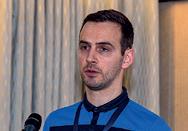
Colin Hutchison Chief Executive Scottish Athletics
Ties that bind . . . close link between elite and grassroots is so precious


sport to organise training, plan and attend competitions, deliver competitions and all at the same time as keeping the day-to-day operations of our clubs and sport ticking along.
To thrive, our sport needs quality facilities to meet our requirements in track and eld and beyond.
The wider public nances continue to present a challenge for our sport and no bigger than at Grangemouth Stadium which is a key facility for national competition. Led by scottishathletics and the local clubs, discussions continue to present a viable solution to keep Grangemouth Stadium operating.
As we move from the summer into autumn and the start of the cross-country season it is also the time of year when we host the
The 4J Awards present the opportunity for the athletics community in Scotland to recognise those that have delivered outstanding contributions to the sport in 2024 and over several years through our Honorary Life Memberships.
For the 4J Awards themselves we have received 76 nominations for athletics alone which is one of the biggest responses we have ever had.
Congratulations to all those that have been nominated for an Award and good luck!
I hope you all enjoy reading this memorable edition of PB.
‘It’s been a brilliant year for the Scottish pathway’ – Liz McColgan
Liz McColgan will be our Guest of Honour for the 4J Annual Awards in Glasgow in October.
We are thrilled to be welcoming a legend of our sport, who won World Champs gold and Olympic silver in a stellar career, to helps us celebrate another great year.
Tickets are on sale now for the event at the Glasgow Hilton on the evening of Saturday 26 October.
The 4J Annual Awards will see the coronation of our 4J Athlete of the Year and 4J Para Athlete of the Year and a big part of the night is celebrating and recognising clubs, Of cials, volunteers and coaches.
‘I am delighted to be Guest of Honour for the 4J Annual Awards for scottishathletics and jogscotland this year,’ said Liz.
‘It is an event to celebrate and support all
Scotland’s mountain runners were in Italy – and came home with a trophy from the Trofeo Nasego event.
The team competed in two World Cup races over the weekend. For the international teams present – Scotland, England and Ireland – the Italian organisers created a three-way competition over the two days of racing for the Nasego 2024 Mountain Running Three Nations Trophy.
Each country had to eld at least two male and two female athletes in Nasego Vertical on Saturday and then the Trofeo Nasego on Sunday.
In Saturday’s Nasego Vertical race Rory Abernethy and Scout Adkin were rst home in the Three Nations competition. Rory had his strongest international race yet to nish in 16th overall and Andy Douglas wasn’t too far behind in 20th.
Scout had a strong run to nish fourth overall, with Kirsty Dickson in 16th and Naomi Lang in 20th. The race was tough going with the temperatures in the low 30s.
that is good in our sport and key to the night is recognising volunteers in the sport in various roles at clubs as coaches and Of cials.
‘These are the people who make the sport happen in Scotland on a weekly basis and help deliver the structure which allows athletes to progress and develop,
‘I think in many ways it has been a brilliant year for the Scottish ‘pathway’
‘We look at the World Indoors and the Olympics and see examples but there are others across other disciplines, age groups and Para athletics.
‘So many of our top athletes came through that pathway and I think it is really important that we celebrate that and thank all those involved. I am expecting a great night in October and really looking forward to my visit.

Another great day of racing on Sunday, saw Naomi Lang (fourth overall) and Andy Douglas (12th overall) lead home the eld in the Three Nations event.
Naomi was backed up by Catriona Graves in 20th. Ross Gollan nished in 14th and was second across the line in the team competition.
So those ne performances in the heat ensured Scotland won the inaugural competition with England in second.
*Eight young Scottish athletes made the long journey to the Palencia region of Spain to race in the WMRA International Youth Cup.
This year’s event (for athletes born in 2007

Liz will also feature in a Q and A session in the afternoon during our Natioanl Club Conference.
‘Earlier on the same day, I will be involved in a Q and A at the National Club Conference.
‘Again, these club folk are the stalwarts of the sport and I anticipate great conversations that day as clubs share good practice and learning – with building on the momentum in athletics in Scotland very much in mind.
‘I am really looking forward to attending both events and having the chance to meet people.”
and 2008), attracted 15 national teams from across Europe and as far a eld as the USA and Mexico.
The highlight for the Scots was the outstanding performance of the women’s team who picked up bronze - the rst Scottish team medal at this event since 2008 when only seven countries were competing.
Well done to Ruth Walsh, Jessica Taylor, Elsa McGregor and Ava Richardson on an excellent team effort.
Eilish McColgan won the Big Half Marathon in London at the start of September – to take the British Half Marathon title.
The four-time Olympian raced for the rst time since Paris and successfully saw off the challenge of Calli Hauger-Thackery to win in 69:14. Weynay Ghebresilasie was third in the Men’s race.
Eilish followed that up with a ne 67:45 for fth in a close nish at the Great North Run.
The Lindsays Cross Country Season will be up and running in October!
AS PB went to press, Entries were open for the District Cross Country Relays at three venues – Livingston, Nairn and Kilmarnock – on Saturday 5 October.
And we are delighted to now share details of further national events and venues for the rest of the winter, with thanks to the Road Running and Cross Country Commission and the various event hosts (clubs and other organisations).
The three signi cant Lindsays Cross Country Season events will be at
*Cumbernauld in October for the National Relays
*Kirkcaldy in November for the Short Course Champs
*Falkirk in February for the National XC
Outside of the Lindsays series, we are making plans for the Inter-District XC Champs to be held at Alexandra Park in Glasgow. There will be a British Cross Challenge element to the races that day as Scotland again hosts on of these events.
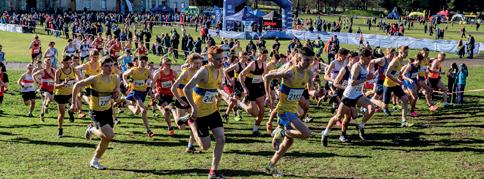
Lindsays District Cross Country Relay Championships
Saturday 5 October 2024
EAST Livingston / NORTH Nairn / WEST Kilmarnock
Lindsays National Cross Country Relay Championships
Saturday 19 October 2024
Cumbernauld
Lindsays National Short Course Cross Country Championships
Saturday 2 November 2024
Kirkcaldy
Lindsays District Cross Country Championships
30 November 2024
EAST Stirling / NORTH Gordonstoun, Elgin /
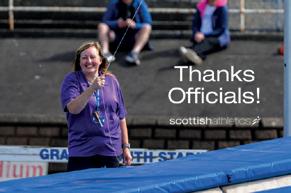
scottishathletics have issued a special ‘Thank You’ message to our superb Of cials.
The purple and red army have delivered countless track and eld events in recent months including two very busy national championship weekends in Grangemouth.
Ayr and Dundee have also been venues for national events while there were district events at Inverness, Kilmarnock and Grangemouth.
We know that is appreciated by the wider
sport and, after a break, we will soon be asking our Of cials about a Conference event in November and to let us know availability for winter events – with a return to the Emirates Arena for the 4J Indoor Season.
Here’s our message to all Of cials from our Competitions Team (Ally, Caitlin, Sophie, Shona):
‘Thank You for volunteering at this year’s National Track and Field Championships – from SUPERteams to the National Relays, to Combined events to championships for all age groups it has been a busy summer!
‘Thank you for your hard work in helping is to stage those events over the past few months.
‘Whether you are an experienced graded Of cial, earning your rst experienced towards a level one quali cation, or just helping out on the day, these events would not have taken place without you.
WEST Barwood Park, Erskine
Inter-District Cross Country Championships (inc UK Cross Challenge)
Saturday 11 January 2025
Alexandra Park, Glasgow
Lindsays National Masters Cross Country Championships
Saturday 8 February 2025
Camperdown Park, Dundee
Lindsays National Cross Country Championships
Saturday 22 February 2025
Falkirk
Scottish Disability Sport Cross Country Championships
March 2025 - TBC
‘National Technical Delegates, Meeting Managers, Referees and Chiefs have also requested we pass on their thanks for your support.
‘We are aware there are still a few events left before the summer concludes. If you wish to volunteer for these events – and there are a number of club chamoionship events – further details can be found on the xtures page of the website.
‘Looking ahead details of the upcoming Of cials Conference will be issued soon and availability for the winter season will be requested.
‘We hope that you enjoyed being an Of cial at this summer’s championships and look forward to seeing many of you indoors early in 2025 (after a well-deserved break).
‘THANK YOU’.


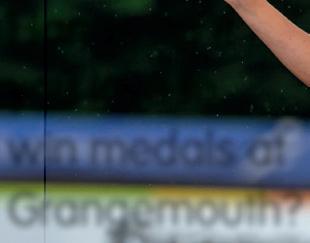
Sarah revels in the double double

Sarah Calvert won a clutch of Scottish championship medals – many of them at Grangemouth – when emerging through the age groups almost a decade ago.
The family mantelpiece, or trophy cabinet, may need to now be extended following the endurance athlete’s progress to the Senior ranks.
Sarah completed a ne 800m/1500m gold double at Grangemouth in August 2023. Come this year’s event, named after Eric Liddell as an appropriate tribute a century on from Paris 1924, she repeated the feat.
Then she cogently explained why the Scottish Senior Champs should still matter.
‘I like having Scottish titles to my name,’ said Sarah.
‘I used to always come here in the age groups and felt it was great racing experience in championships.
‘I have struggled with injury to nd consistency at times so to have a goal of winning titles has helped me. To do it two years in a row feels better than just a one-off and it means a lot to me.
‘I always have a good weekend. And then, if you win, you get to sign your name in the Champions’ Book . . .’
Sarah penned her name rst on the Saturday after 800m gold and then again when the Women’s 1500m went to a straight nal on Sunday lunch-time.
Luke Davidson signed his for the Men’s 800m and his story was writ-large across BBC Scotland output a couple of days later when the spotlight fell on his Liddell example.
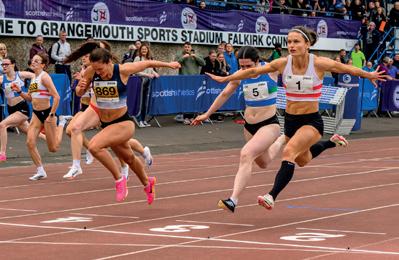
The Inverness Harriers athlete has a strong Christian faith and does not race or train on a Sunday. He entered the 800m at Grangemouth when seeing the Men’s 1500m – duly


won by Andrew McGill of Cambuslang – was timetabled for the Sunday.
‘I dropped into the 800m today (Saturday) even though I am really a 1500m runner,’ said Luke
‘The 1500m was scheduled for Sunday and I don’t run Sundays - so I felt very much like Eric Liddell at Grangemouth.
‘I wanted to represent what he did and his Christian mission. That is more important to me than his running - that’s why he missed the 100m at the 1924 Olympics.
‘I felt I did the same this weekend. I wasn’t sure if I could pull off the same victory he did but – Thank You to God - I did. I don’t think I was a favourite going into the 800m but middle distance races can go any way on the day.’
The 400m races were special at Grangemouth with a commemorative medal struck to mark the centenary of Liddell’s gold over the distance at the 1924 Olympics.
There were awarded across Senior, U17 and Para categories and there was a special medal for the coaches too.
Jilly Cherry won arguably the pick of the onelap races and her PB run of 53.26 to see off Zoey Clark and Georgina Adam was one of the standout performance of the weekend.
Zoey had won the 100m in 11.68 but had to settle for two further silvers in a hectic weekend when ‘I sprinted a full mile over seven races’.
Lois Garland was second in the 100m but turned that around to successfully defend her 200m title on the Sunday.
‘I was wearing that ‘defending champion’ logo on my number so it’s always good when you manage to win in those circumstances,’ said Lois.
Dean Patterson won the Men’s 200m in 21.10 with Krishawn Aiken adding silver to the 100m gold he had won the previous day in 10.43 (windy).
There were title wins in the Women’s 5000m and 3000m steeplechase for pals Stefanie Tucker and Alicia Paton, both coached by Mike Johnston (like Andrew McGill), while Ben Potrykus had the nish required to secure the Men’s 5000m after a good race.
William Hodi won sprint hurdles gold for Nairn Area AAC and the women’s nal there was the closest of the weekend – with Erin Campbell of Giffnock given the photo nish nod over Aberdeen’s Jane Davidson with both timed at 13.86 seconds.
It was captured well in our Vinco Sport highlights on YouTube on a weekend which, despite gaps in some events, once again delivered the drama worthy of the 131st version of the Scottish Senior Champs. And Eric Liddell.
Photos by Bobby Gavin

Athletics isn’t rocket science when it comes to delivering championships - more depth in events breeds deeper competition and stimulates better performances.
Big numbers at Grangemouth for the Eric Liddell Senior/U17 Champs demonstrated that with a brilliant 776 names on start-lists.
And the best example came right in front of the stand on Sunday lunch-time.
For the second successive year, the Men’s Long Jump competition enthralled families, coaches, spectators and Of cials, This time there was even the additional element of ‘living up to the hype.’
Entries by Stephen MacKenzie, Alessandro Schenini and Murray Fotheringham offered plenty promise but they still had to deliver. In the end, Stephen went third all-time with a 7.92m leap for victory while Alessandro (7.74m) and Murray (7.69m) could certainly feel they contributed to that.
‘I think the guys brought the best out in each other and that’s what you hope for in a long jump comp,’ said John Scott, who coaches Stephen.
Nick Percy swapped the Olympic ame for the Grangemouth re nery as backdrop for his latest Scottish title success.
A throw of 62.37m was the second best of his career in Scotland for the Paris 2024 Olympian.
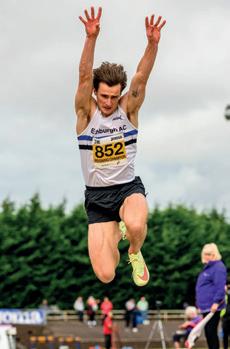

‘Alan was President way back then and had the big chain of of ce at the time,’ recalled Nick.
‘I was just a young kid but I asked him if he would swap that chain for my medal. It became A running joke for year at medal presentations and it continued when Leslie Roy was in that role.
‘I met Alan when I arrived at Grangemouth but he was of ciating in declarations. It was nice for him to hand over the gold.’
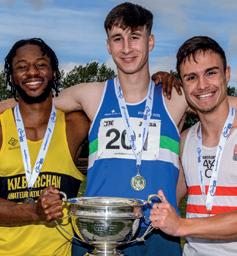
And in a special moment at Grangemouth he received his gold medal from Alan Potts – the former scottishathletics President who presented Nick with his rst Scottish championships medal some 15 years ago.
Nick’s throw earned him a slice of our £3000 prize-pot and there was a further Olympic connection on the podium. Josh Kerr’s brother, former professional rugby player Jake, took a bronze only ve weeks into his throwing career.
Kirsty Law collected her 15th (yes, fteenth) Scottish title in the Women’s discus , Greg Millar the Men’s javelin and Cumbernauld AAC athlete Hannah Wallace won the Women’s Long Jump with 6.09m. Amy Kennedy in the shot was another Cumbernauld AAC champion.




Henry Clarkson’s triple jump winning distance of 15.93m was one of the best in the history of that event.





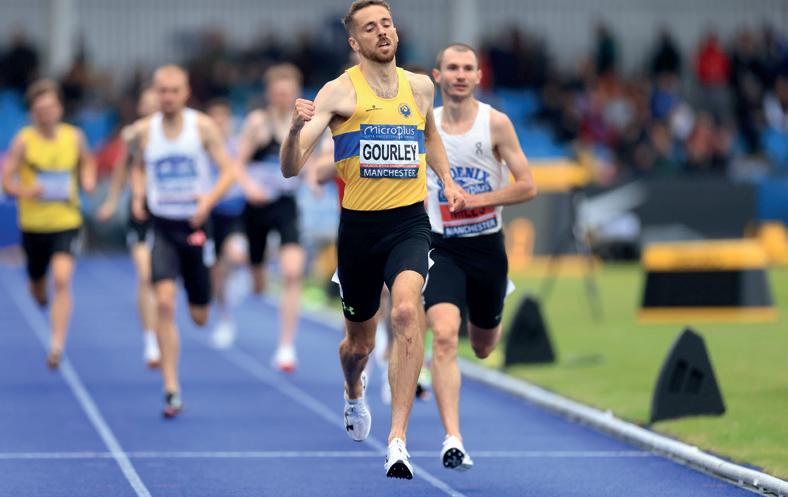
Gold: Neil Gourley, Steven Bryce, Samantha Kinghorn
Silver: Laura Muir, Jemma Reekie, Melanie Woods
Bronze: Erin Wallace.

By Peter Jardine
To say Neil Gourley’s start to the Olympic year of 2024 was unorthodox, not to mention dif cult, would be something of an understatement.
The mental anguish of missing out on the World Indoors in his home city of Glasgow was hard enough to take.
But the physical pain of surgery for back and pelvic issues over the winter which left him brie y unable to walk – and certainly not able to contemplate going for a run – seriously endangered his ambitions to win selection for Paris.
Endless hours on a bike were the only option and Neil, leaving no stone unturned, enlisted the help of a sports psychologist who had
experience in the Bolshoi Ballet in Moscow to help him tiptoe through the injury rehab.
Then, as the British Champs and Olympics Trials loomed in Manchester on the last weekend of June, the nal push from Neil came . . . at Ravenscraig track in Greenock with Scottish Athletics Head of Performance, Mark Pollard, ‘pacing’ the Giffnock North AC athlete on the bike.
One week later and the wheel of fortune tuned in his favour and an Olympic place was secured.
‘Three years ago I injured my calf a couple of times in the countdown to the Trials and it became clear I had no chance of Tokyo,’ said Neil.
‘That was tough to take after being in the 2019 World Champs nal.
‘Then, this year, three months I wasn’t able to run, never mind quickly. So winning gold and clinching selection was a huge was a relief. Tthe weight on my shoulders has been lifted and I am proud that I am able to become British champion again.’
Gourley looked comfortable

throughout and with George Mills leading with 150m remaining he simply went up a gear and cruised into the lead as they entered the home straight in Manchester.
‘If I was to draw a race plan in my head of what I would want it would be the race today. Throughout the race I felt comfortable and there wasn’t a moment I didn’t think I wasn’t going to win. I had my family here today to support me so today means a lot, not only for me but this is for them.’
If Josh Kerr had drawn up a plan for the 800m nal then it was ripped to shreds around 70m from the nish. With a slight gap on the inside, Josh sought to push beyond Elliot Giles in a bid to land a medal. Instead,



both athletes ended sprawled on the track.
That outcome slightly affected a Scottish medal tally which included Jemma Reekie and Laura Muir both claiming silvers. Placing in the top two was their minimum requirement to make Paris and both did exactly that.
Jemma nished second in the Women’s 800m to teenager Phoebe Gill. Just behind those two was Erin Wallace with a solid run for third - after also being on the UK Champs podium indoors.
It was similar in the Women’s 1500m as Laura was overhauled on the home straight by winner Georgia Bell.
The Scot had to settle for second but quali cation for her third Olympics felt like more than compensation.
‘Back in 2012 prior to the Olympics being in London I was at the British Champs and Trials – and nished last in the Women’s 1500m nal,’ recalled Laura, with Sarah Calvert placed eighth in that nal with 4:15.58.
‘So if you had told me then that I would later go on to make the British team for the Olympics three times then I would have been absolutely delighted.
‘Selection is a massive honour and in this sport you can’t take anything for granted. I was as nervous as I can remember prior to Sunday’s race because you know if you fall over then it can cost you very heavily.’
Three Scottish medals was the haul from just two races for Para athletes in Manchester.
Steven Bryce saw off all challengers to take the win in the Men’s 1500m Ambulant race.
That was followed quickly by a strong push from Samantha Kinghorn for victory in the Women’s 400m Wheelchair race. Melanie Woods made it a Scottish 1-2 in terms of the podium there.
‘I’m pleased with that performance and the time at 54.55 is good for this track – the surface here isn’t one I like all that much,’ said Sammi, with Melanie at 56.98.
‘What I did like was the atmosphere and the crowd in the stadium. Even going round after the race and being applauded helps remind me why I am doing this.’
Sarah Tait came up with one of the best other performances for fourth in the Women’s 3000m steeplechase nal. The Lasswade athlete clocked a PB of 9:49.88 and moved third on the all-time list.

ick Percy featuring on the podium at the UK Champs has been as close to a ‘sure thing’ as is possible in British athletics for a decade.
A silver this year ensured his ninth visit to the medal ceremony in ten years with the discus thrower rightly hugely proud of that consistency.
Nick was less impressed with his best throw in Manchester this year, however, and missing out on the gold medal clearly hurt the Scottish Record holder.
And yet, over time, the 29-year-old might come to regard that silver medal as the very best of his career.
With the Olympic standard posted in America earlier in the year, Nick HAD to deliver top two at the British Champs or risk missing out on an Olympic debut after almost two years in the sport. The implications of third place that day hardly bear thinking about.
‘I have no shame in saying that when the call comes in about Olympics selection I will be a blubbering mess crying,’ Nick told us that afternoon.

‘It has been such a long journey for me in the sport. PBs and medals along the way, a couple of years where I didn’t really progress, and then taking further time to develop to where I’m at this year.
‘In my teens as a Junior I went from Isle of Wight on a ferry and then a two-hour car trip – just to get to training. I spent multiple hours doing homework in the car. I gave up other sports early to focus on the throws. So there are sacri ces all along the journey.’
Nick’s silver was one of three in eld events for Scots that Saturday in Manchester.
Will Grimsey took gold in the UK Champs for the rst time on the brink of his retirement decision. Will wasn’t happy with a winning height of 2.15m but the gold medal around his neck offered signi cant compensation.
Alessandro Shenini for his part was delighted with long jump bronze at 7.77m in a nal which saw three Scots make the top eight with Murray Fotheringham and Adam Hoole involved. Henry Clarkson was our best performer in the triple jump at fth place.
‘I wasn’t sure I was going to do British Champs this year as I’ve had some tough time with mental health recently,’ he said.
‘To win a medal at this level feels really good and I have to keep telling myself that this is my best season in terms of consistent jumping.’
Gold: Will Grimsey
Silver: Nick Percy
Bronze: Alessandro Schenini
Joanna Roberston resorted to Google when forced to recalibrate after a lifechanging car accident ve years ago.
The occasional sportswoman and recreational swimmer was seeking inspiration after being asked to check out wheelchair racing as a possible new pursuit.
Finding out more about Samantha Kinghorn gave her a role model to admire and began to fuel her own ambitions as a Para athlete.
Joanna’s story is told superbly in a short documentary created by Urbane Media for scottishathletics and Athletics Trust Scotland.
‘In 2019, my family and I were involved in a car accident,’ said Joanna, who is coached by Phil Owens and represents Aberdeen AAC.
‘The car lost control and unfortunately we crashed. I sustained a spinal cord injury that resulted in myself becoming paralyzed from the waist down. I could no longer feel or move my legs. I was fortunate. I still have my hands. I still have my upper body. I could still lead an independent life.
‘I remember staring up at that horrible ceiling for so long, unable to move myself from having metal work and recent spinal surgery. I remember thinking to myself, like, this is it: it’s over. What’s the point now?
‘It was so overwhelming navigating life in this new body. The challenges can start as small as: how do I get in and out of bed? You know, how can I dress myself? There’s so many more obstacles than you think you know, a single step could stop you.’
Accessing a wheelchair, and racing chairs, brought about a change of focus.
‘It’s slow progress, but the wheelchair is like a source of freedom for me now.
‘Prior to my accident, I was a keen swimmer. I rst heard about wheelchair racing from my physio, Claire, and she mentioned Sammi

Kinghorn. Samantha Kinghorn is a world renowned wheelchair racer.
‘Of course I look her up on Google and I see wheelchair racing. The women there looked strong, compassionate, determined and they made it look so cool.
‘And I was like, I want to do this.’
‘Race chairs, as I soon found out, are not cheap. It took a while to get the funding. We eventually managed to get my own chair measured up at Bromakin, which is down in Loughborough.
‘When I rst got into that chair, I felt so much joy. I realised how quickly I can go. And I discovered more about myself; how much stronger I can be and I had more goals and aspirations for that. ‘Then when I get in that race chair, you become part of the machine you slot so easily into it and it is custom-built for you.
‘My biggest guide in all this is of course, my coach, Phil Owens. Phil has very much helped guide me through all this because I wasn’t into sports before this. You know, I did it very casually. So he has been keeping me right.
‘He’s been keeping me motivated and keeping my eye on the prize.
‘It’s from going to these track races, going
to these marathons, that you meet other wheelchair races because there’s so few of us out there and you immediately get that connection because they understand. They know what it’s like.
‘It’s just incredible, the people you meet in this sport, you know, and it’s such a fantastic community. ‘
Joanna and Zoey Clark featured in the two short documentaries created by Urbane Media. At a special screening in Cineworld in Aberdeen, both spoke passionately about their sport as presenter Myles Edwards stressed the importance of support for Athletics Trust Scotland.
‘If I can give myself advice when I rst started wheelchair racing, when I rst got out of hospital in general with this whole life change, it would be to be persistent,’ says Joanna in the lm.
‘You know, fail and fail again and keep trying. You just have to keep doing it, keep showing up, keep going. And one day it’ll click and I promise you it will happen.
‘That’s what I would tell myself at the very start of all of this.’

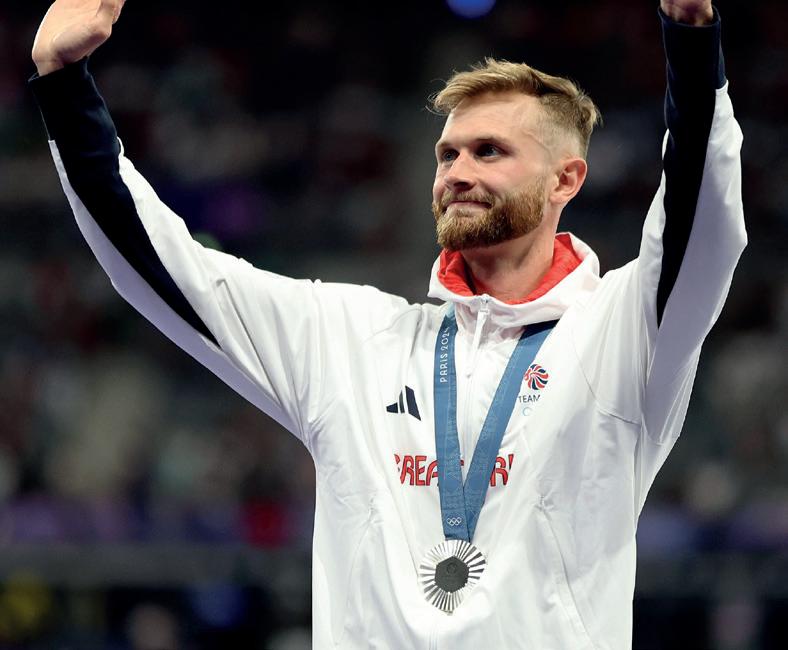


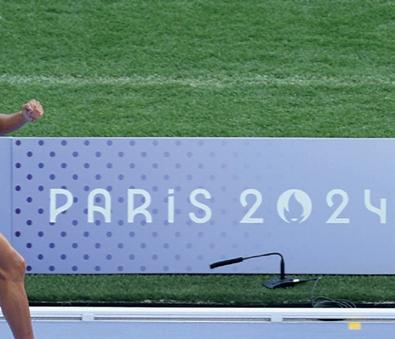



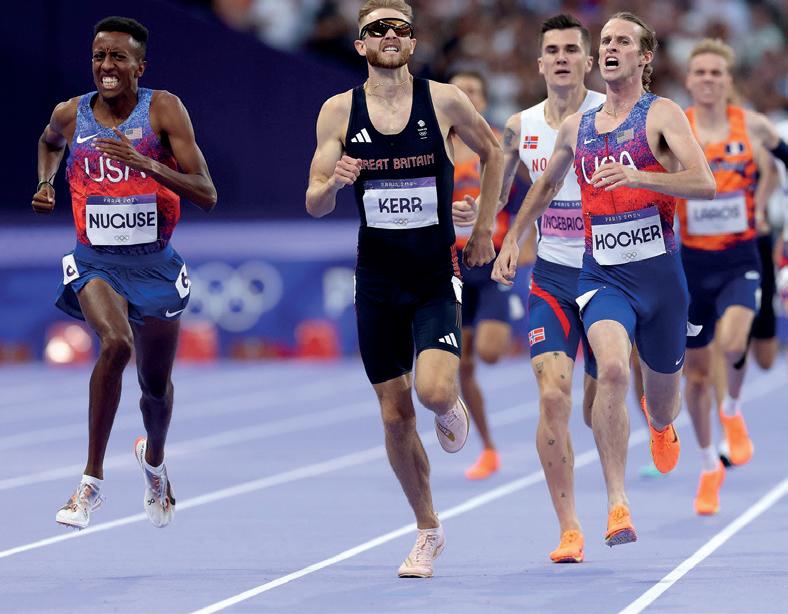
By Peter Jardine
It was Tom Cruise, or rather his Top Gun character naval aviator Maverick, who colourfully articulated his ambitions as he joined the United States pilot academy in California.
‘I feel the need; the need for speed,’ he tells fellow entrant, Nick ‘Goose’ Bradshaw.
Josh Kerr, Yared Nuguse and 10 other middle distance acolytes must have experienced something similar in the bowels of the Stade de France prior to an eagerlyawaited Men’s 1500m nal at Paris 2024.
Josh had predicted a ‘dog ght’ after all and so it proved, albeit with a twist in the script over the nal few metres to the nishing line.
Cole Hocker became an instant American hero with an Olympic Record – at 3:27.65
– to garland his gold medal. Top Gun, right enough.
Josh was ‘forced to settle for silver’ although that particular phrase feels slightly harsh given his achievements included the British Record and medals at back-to-back Olympics (the rst track and eld Scot to do so).
Jakob Ingebrigtsen, the erstwhile Olympic Record holder and the champion from Tokyo three years ago, meanwhile had to settle for posting his congratulations on Instagram to those on the podium . . . so often the Norwegian’s personal efdom. Nuguse? He was just one hundredth of a second behind the Scot to take third and join Hocker in the American ag-waving party.
Almost from the start-line, Ingebrigtsen was the man out in front and ‘there to be shot at’ if we continue the ghter pilot parallel (for the last time, honest).
The others had to keep him in their sights for three laps or so – then overhaul him. For long enough, it looked like that strategy might not prevail.
Watch the race back and well into the home straight and the storyline still seems to be the Josh v Jakob showdown so many had forecast. The Norwegian is still ahead with, what, about 70m remaining.
Then, aware of the threat from Kerr and Nuguse, he moves slightly to his right and
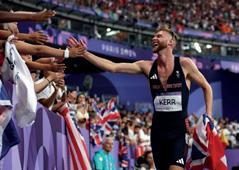



opens a gap for Hocker – as he himself is passed by the Scot and the other American, Nuguse.
When the dust settled, and this race created a lot of dust, just 15 hundredths of a second separated the three medallists in the 1500m. What a script.
‘We have had a lot of storylines this year, back and forth with me and Jakob and things like that, but I know how talented that 12man eld of the best 1500 metre runners in the world is in the last four years,’ said Josh.
‘I knew that there could be threats coming from the Americans with three of them in the nal.
‘They were going to come away with at least one medal I thought. I have a lot of respect for everyone. Cole (Hocker) put together a performance that is the best that the Olympics has ever seen.
That’s good enough for me for silver today

and it’ll get me hungry.’
Ingebrigtsen, who placed fourth, was gracious in defeat this time.
‘It didn’t go according to plan,’ he said.
Referring to Josh, he added: ‘Well, I guess he did show up after all – and so did Hocker and Nuguse.
‘My team always say to me ‘because you have such a big mouth and are the one to beat, you have everything to lose in these competitions’. Today, Cole, Yared and Josh outsmarted me.
‘They were the ‘best guys’ when it really mattered. And I want to congratulate them all on a great performance.’
Fair play and Josh too was complimented on his magnanimous verdict post-race.
Were they too xated on each other? It would be a harsh analysis on Josh after a PB run which took down Mo Farah’s mark from a 2013 paced Diamond League race in Monaco.
And athletics folk really should not be too pofaced about the hype this nal generated.
For months it added an edge, built interest, and raised pro le. Did Josh and Jakob bene t nancially? Almost certainly – though Hocker landed the $50,000 from World Athletics for gold, with these payments introduced for the rst time at the Olympics.
But we can’t bemoan a lack of media or public interest and then complain when it is generated.
When Josh puts on those shades the feeling lingers that it is ‘show-time’ and he knows exactly what he is trying to do to elevate the spectacle.
Los Angeles and the next Olympics is still four years distant. There will be plenty of ‘dog ghts’ on the track to savour in the interim.
The beauty of the Men’s 1500m nal in Paris is . . . it wasn’t ction.

The partnership between Neil Gourley and his club, Giffnock North AC, has become the perfect example of what we regularly call our #SALtogether ethos.
That’s when everyone in the sport has a role to help drive growth and momentum – from our elite athletes to coaches of our U11s.
Few demonstrate that better than Giffnock and Neil and the body of evidence of that link was very much apparent before, during and after the Olympics.
Neil became the club’s rst Olympian and then, after serene progress from the heats and the semis, their rst Olympic nalist.
The ‘Good Luck, Neil’ and ‘Welcome Home, Neil’ messages from the full club demonstrated that support system empatically.
Come the nal, Neil delivered the third fastest 1500m run of his career to take a very creditable 10th place.
‘It was incredibly quick from the start, I always knew it was going to be,’ he said,
‘I don’t think that was a surprise to anyone with the athletes who were in the race and their reputations.
‘It was aggressive. I tried to hold on for as long as I could but I kind of knew I was at my limit and it was still early stages.
‘I gave it everything to hold on. I died a little bit at the home straight but I don’t regret that part.
‘My approach was that it is not a huge difference between 10th or eighth or whatever – I had to try to do all I had to be in medal contention. I’m glad I raced it that way,
‘Naturally I wish I could have hung on for longer. But I spent everything just trying to hang tough with those guys.’



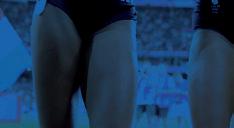
By Peter Jardine
From American footballer to Olympic double relay medallist – just as well Nicole didn’t quit


ilidh Doyle’s rst taste of sporting success was as a swimmer in her early teens while Neil Gourley played rugby to a good level in Glasgow.
Eilish McColgan dipped her toes in hockey and her rst athletics medal was in high jump at a Dundee schools event.

So ‘talent transfer’ stories are not


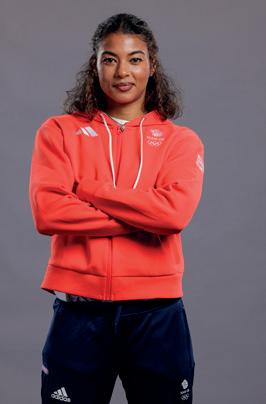
uncommon among our well-known Scottish elite athletes.
We respectfully suggest however that the Nicole Yeargin story is hard to better. As recently as her late teens, the now double Olympian and double Olympic medallist, played American football for her high school team Bishop McNamara High School in Maryland.
Social media posts from the States during the Olympics highlighted her initial role as a ‘kicker’ – long before she pulled on the sprint spikes at the University of South California.

Nicole had also previously taken part in gymnastics and soccer.
‘I played for the men’s team, the coach knew I played soccer and he saw me in the weights room - I used to powerlift a lot - and asked me to try out for the American Football team,’ she recalled in a previous interview with BBC Scotland.


‘When I rst started kicking, it wasn’t the best. But I worked hard and in my senior year my percentage for making the kicks was very high and I was the rst female to play in our conference against the men.
‘I really just joined the track team at the end of my senior year to stay in shape. Then I ended up running a 300m and found out I was fast, and that is how I moved into track.’
Just as well she did after not one but two bronzed medals with the Team GB relay squad in Paris.

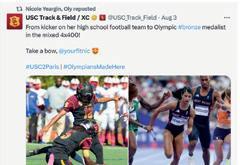

Nicole helped the Mixed 4x400m Relay team land a British Record in the heats early in the athletics programme. Left out of the team for the nal, she still landed a medal having run.
Then, in a reverse scenario, the Scot was brought into the Women’s 4x400m team for the nal after a completely different quartet ran the heats. This time Nicole was on the third leg and handed over to Amber Anning to ght with Ireland and the Netherlands for silver and bronze.

Not too long ago, however, she had pondered quitting the sport after the pain of missing out on the GB and Ni team for the World Indoors at Glasgow 2024.
‘Two-time Olympian and two-time medallist . . . that’s pretty crazy,’ said Nicole in Paris.
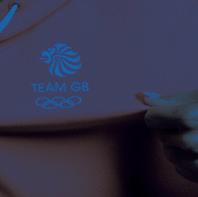
‘The rst medal was like, ‘yeah, I got it’. But to run the nal and do my team proud puts the cherry on top.’
Yeargin - who turned 27 the day after the Women’s 4x400m nal – had a disappointing



indoor season, with a poor showing at the British Championships ensuring she missed out on Glasgow 2024.
At that stage, she considered quitting entirely before re nding her focus in time to earn a place in the GB Olympic team.
‘I was ready to hang up my spikes,’ added Nicole, whose mum is from Dunfermline and whose grandmother still lives in Scotland.
‘When I came off the indoor season I was a little bit like ‘what is going on, shall we hang these [spikes] up? I don’t know if I have got it in me’.

‘Then I talked with my coach (Vince Anderson) and realised what went wrong and if we can change it, I have full con dence I can make it back. One day you can be on top and one you can be on the bottom, athletics is very unforgiving.
‘But once you tune back in and give it your all, it’s amazing what can happen.

‘I’m so emotional thinking about it because I thought I didn’t have it anymore, and so now to be a two-time Olympic medallist . . .’
Twice from Paris, Nicole took time out to send ‘Thank You’ messages to the athletics community in Scotland by video and Pitreavie AAC are hugely proud of their latest Olympic medallist.
‘There’s more still in the tank and I cannot wait for the years to come,’ she concluded.
‘I’m in there for another four years for sure and it’s now all about Los Angeles.’
Nicole is ready to kick-in, in fact . . .
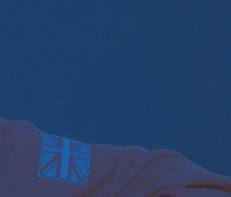

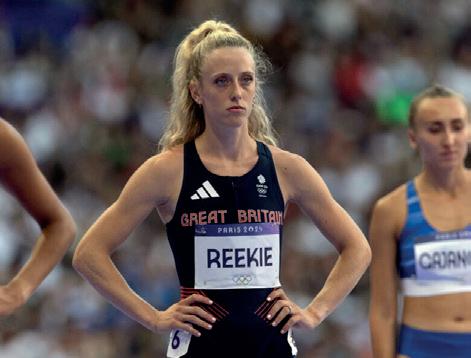
When Jemma Reekie closed out her 2024 track campaign there could be an argument to say it was one of her best seasons ever.


The World Indoors Women’s 800m silver medallist has been consistently around 1:58 and, of course, the highlight of the summer was a superb Scottish Record in the London Diamond League at a rapid 1:55.60.
But Olympic disappointment hurt with a semi- nal departure certainly not what Jemma and coaching team Jon Bigg and Sally Gunnell had hoped for.
With only two automatic quali ers and two more, Jemma was squeezed out in fth place in a race where the top four made the nal.
It’s remarkable, really, that 1:58.01 wasn’t enough.
‘It was really tough, and I’m in the best shape of my life, and I was coming here to ght for one of those medals,’ said Jemma immediately after the race.
‘But it’s the Olympics, it’s really tough out there.
‘I was happy with the way I ran it but I’ll have to watch the race back and see what I can do better. Those girls came round very strong, everyone has raised their game for the Olympics.
‘I felt I had built on things (since the London run) over the past few weeks and training has gone really well.
‘But we’re athletes at the end of the day and we’re not going to have a perfect day every day.
‘I ran it the way I wanted to, and I think I ran it my way to give myself the best shot of a nal.’
So, an imperfect day in Paris. But Jemma Reekie’s career path thus far suggests only one outcome: she will bounce back.
*As PB went to press, Jemma was preparing to compete in the Women’s 800m Diamond League nal in Brussels after getting back on the track only a couple of weeks after Paris.



‘I left everything out on the Paris track’ – Laura

Andy Murray was in between his Wimbledon title wins and Faith Kipyegon hadn’t even won any of her three Olympic titles in the Women’s 1500m.
It was the summer of 2015 when Laura Muir rst plunged into the deep waters of competition in a global nal.
The 2015 World Champs were held in Beijing in China and Laura nished fth in 4:11.48 in a race which was slow over two laps before the inevitable burn-up saw Genzebe Dibabe take the gold.
Scrolling through coverage on our own website the introduction to the race report rather stands the test of time.
It reads:
‘Laura Muir emphatically con rmed her arrival on the global stage with a ne fthplace nish in the World Champs.’
And how! Scroll forward a further nine years and Laura’s appearance in the Olympic nal in Paris was eight-in-a-row at this level – ve at World Champs and three at the Olympics.
The arrival was in Beijing in 2015 and the journey has stretched to (minimum) nine years. As Murray, who won Wimbledon in 2013 and then 2016, exits stage left, Laura is still centre-stage.
Class and consistency sum up that rather remarkable sequence which was highlighted by European Athletics in the countdown to the Saturday night showdown in the Stade de France.
The outcome was to be fth again in a nal which started fast – as Ethiopian Gudaf Tsegay effectively became the pacemaker for her team-mates (and the rest of the eld) - and never let-up.
Consolation, if that’s the word, for Laura came via a Personal Best in the Olympic Final and a new Scottish Record of 3:53.37.
Kipyegon won gold with an Olympic Record and Australia’s Jessica Hull took the silver. Laura’s fellow Team GB runner, and the British champion, Georgia Bell, took the bronze with a new British Record (ironically rewritten only a few weeks earlier by Laura in Paris).
In the blur of that nish – and it was close between the athletes from places two to ve – all sorts of theories and analysis were spawned.
But Laura’s own view was unequivocal and there have been races, and nals, in those nine years where committing too much too soon has not ended too well.
‘You know what? I am really happy with that because that is how I wanted to run,’ she said, after runs of 3:58 in the heats and 3:59 in the semis.
‘I knew I could run 3.52/3.53 in my splits but it was a really quick nal.
‘I ran a second faster than I did in Tokyo and this time I got fth. There’s so much strength in this race. It’s mad how much the sport has moved on since then.
‘I ran that race exactly like I wanted to. I
just knew I couldn’t keep that pace up at the start. I had to be patient.
‘We knew I could run a very fast time, and I did. I ran a big PB and I wouldn’t change anything about that race.
‘I was exactly where I wanted to be, I thought they all ran so hard. I caught up to a lot of them but unfortunately I was a couple of metres short.’
In all manner of measurements, there is only one certainty in Laura Muir’s career: when the time comes to put it into context, it won’t come up short.
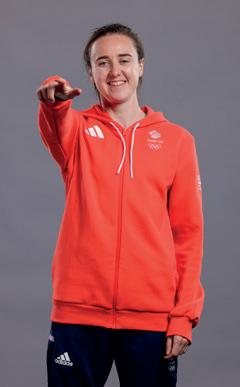

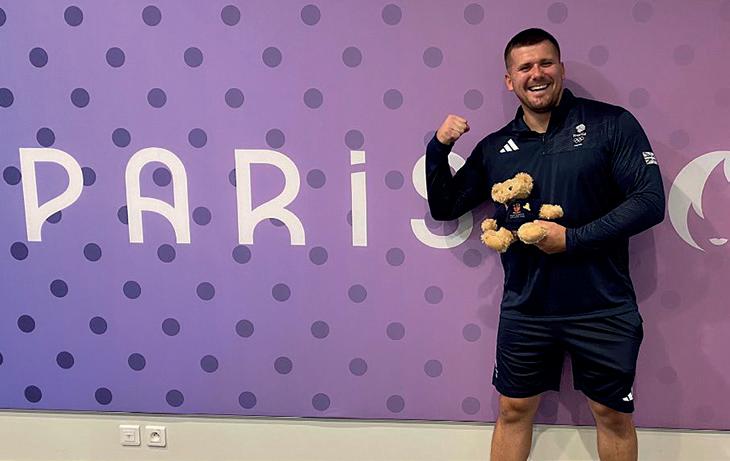

Nick’s ‘channel hop’ to Paris after a 15-year discus journey
Nick Percy’s achievement in qualifying for the Olympic Games is probably best exempli ed with a historical note on Scots in that event.
It is fully 64 years in fact since a Scottish male athlete threw in the discus event at the Games.
Mike Lindsay competed at the Olympics in 1960 and 1964 in the throws with the former being in the discus.
Nick, who always has a keen sense of history, context and the numbers around the sport, knew precisely what Paris quali cation meant.
‘When that news is con rmed, I don’t mind admitting I will be a blubbering wreck and the tears will ow,’ he told us in Manchester after second place alongside the standard he threw in Ameirca was enough to secure his place.
He took that attitude with him to Stade de France and, in truth, reaching the nal looked a really tough ask with only 12 men assured of a place from 32 entrants.
Nick threw out to 61.81m to nish 12th in his quali cation group (of 16) and that was not enough – with global standards high.
‘I am feeling absolute joy,’ insisted Nick in Paris.

‘This is my nal, being here at this event. Seeing how well everyone is throwing it was de nitely the highest standard to reach a nal ever.
‘It’s the Olympic Games and there is a lot of pressure, you only have three attempts, it is not easy. I am really proud.
‘The last few weeks have been a struggle emotionally. I said to my family and coach beforehand, if I walk away with a 62m throw, I have done very well. 61.81m, you are basically there.
‘In the last round, it is very rare that you can say you have nearly 70,000 clapping for you. It is a real emotional thing. I am taking it all in, I don’t want this to end.
‘It is such a special day, so there is no disappointment. I managed to give my mother (Deborah) and sister (Brogan) a big hug after the warm-ups. It was so special to have family support.’
In the sport for years, this was a culmination in many ways for Nick, who built a DIY throws area in the garden of the family home in the Isle of Wight during the Covid pandemic.
So it was great to hear him talking about next year and even the next Olympics.
‘Sometimes you feel you have a target on
your back, you see things online, you feel the pressure,’ he added.
‘We found a slight Achilles issue after Manchester that we thought was just a niggle but was a bit more than that. I managed to get on some medication for that.
‘But after the end of the season I will rest up and relax.
‘Then I will start to get ready for next year. The experience in Paris really whets the appetite to keep throwing far.’
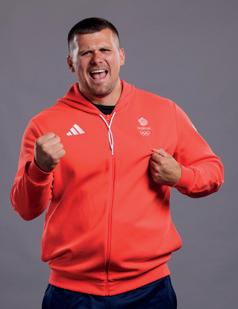




Scottish stars perform well in Paris and show they are classy role models, too says David Ovens
We will always have Paris...
Nine days shook the world when eight Scots took centre stage at the Stade de France for the 2024 Olympic Games.
Everyone will have their own favourite moments from action which was high calibre and utterly compelling.
In the aftermath the numbers were signi cant and we have laid out many of those on this special PB spread.
The global nature of track and eld is well worth highlighting. In Paris, 184 nations were represented in athletics and 43 different countries won at least one medal. A total of 75 nations had top eight nishes.
While the performances are hugely important, of course, image is increasingly relevant in sport. The optics, to use the vernacular, can sway opinion both via the mainstream media and across social media platforms.
We asked scottishathletics Chair, David Ovens, for his thoughts and David underlined that aspect, too.
‘The dust has settled on the Paris Olympics and we can all re ect on a fabulous Games for Team GB and for our Scottish contingent

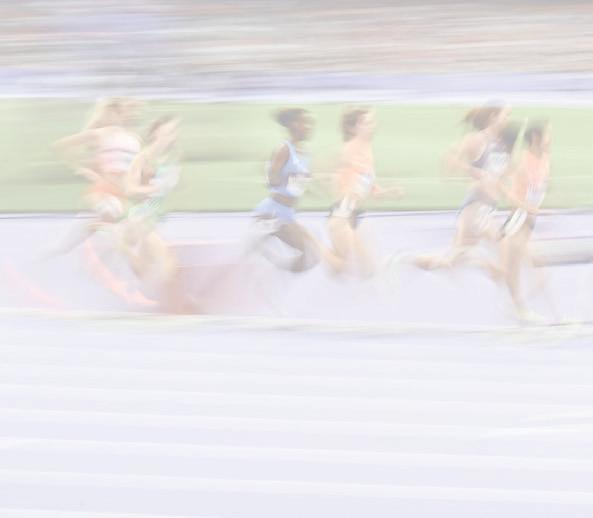
befell them with grit, grace and gravitas.
‘Who could forget Josh Kerr’s ghting talk and supreme con dence ahead of his nal and yet the grace with which he re ected on just missing out on the gold medal in the nal stride of the race?

‘Nine Scottish athletes were selected as part of a 64-strong Team GB athletics squad (although that became eight when Jake Wightman was a late withdrawal through injury). The Scots with Team GB returned three medals out of a total of ten, along with a raft of ne performances.
‘We have become accustomed to this level of success by our Scottish athletes in recent years and it is undoubtedly inspiring the next generation of young athletes to believe that they, too, can compete at that level with the best in the world.
‘However, one thing which particularly struck me was the extent to which each of our athletes handled the circumstances which
‘Laura Muir ran a stunningly gritty race to secure a Scottish Record and fth place (to add to her silver and seventh from previous editions). Ten more metres and she might have secured a medal, yet in her post race interview, she looked back with pride at her race strategy and execution and was full of praise for her team-mate, Georgia Bell, who nished just a stride or two ahead of her securing the bronze medal.
‘Such are the ne margins between gold and just missing out on the medals at this level.
‘But the abiding memory for me was the Women’s 10,000m nal on the Friday night of the closing weekend.
‘There was no medal for Eilish McColgan this time, but she showed true grit after a tremendously dif cult, injury ridden build up, to nish 15th overall and third European. Then Eilish waited around at the nish to comfort and congratulate Olympic debutante Megan Keith, who struggled, but who



showed immense grit and determination to complete the race.
‘For Eilish, it may have been her last Olympics on the track, but for Megan it will undoubtedly have been the rst of many. For both of them, their efforts and support for each other showed true class in front of a global audience.
‘It is this culture of success and support, built up over many years, which makes the athletics scene in Scotland such a wonderful eco-system to be part of for so many people.
‘It creates rm foundations for future generations to believe that they too will be capable of ful lling their dreams.

‘Our top athletes are magni cent role models who are at the top of their game, yet they too have come through our grassroots club and competition structures and have been supported by our brilliant coaches, of cials and volunteers. The pathway in Scotland is so very clear.
‘To our superb athletes in Paris: thanks for the wonderful memories!”







medals won is the best since Scots won four at the 1920 Olympicsequalling the three medals won in 1980 and 1988.
With thanks to Arnold Black, scottishathletics Historian 1 24 3 2 132 4
Eilish McColgan and Laura Muir each became the first Scots to compete in finals at three Olympic Games.

Laura Muir’s appearance in the Women’s 1500m was of course her third in a row in the Olympics. It was also Laura’s 24th final across major international events indoors and outdoors.








our clubs celebrated representation at the Olympics for the first time. Megan Keith was the first athlete from Inverness Harriers to compete at the Games and similarly Giffnock North Ac celebrated Neil Gourley as their first Olympian (and first Olympic finalist).










Scottish athletes have now competed in track and field at the Olympics. Making their first appearance in Paris were Megan Keith, Neil Gourley and Nick Percy.

Eilish was selected for the fourth time in her career after appearances at London 2012, Rio 2016 and Tokyo 2020 (which happened in 2021). Eilish is the first Scot in track and field to compete at four Olympics
Olympics in a row with Scots involved in the 1500m finals. There were two men (Jake Wightman and Josh Kerr) in the Tokyo final and Laura Muir in the Women’s race. This year, it was a repeat story with two (Josh Kerr and Neil Gourley) and one (Laura) again.


2 8



For the eighth successive major championship event, a Scot (or Scots) appeared on the medal podium. That sequence began in the 2022 World Champs in Oregon when Jake Wightman, Laura Muir and Nicole Yeargin landed medals.



Cuddle after the struggle proved sport is about more than just winners


By Peter Jardine
When Derek Redmond attended the Scottish Athletics Awards Dinner as our Guest of Honour a few years ago he wasn’t asked to bring his medals. Only his memories.
UK sprinter Redmond, it may be recalled, featured in one of the best-known Olympic moments when a hamstring injury cut short his 400m run at the Barcelona Games in 1992.
He was joined by his father on the track and limped to the nish line amid cheers of sympathy and support.
Come our Awards Dinner and Derek actually re-enacted moment across the dance oor of the Glasgow Hilton – to enormous applause.
It remains a huge hit on YouTube and demonstrates one simple truism which is often apparent come huge global events like the Olympics: Sport isn’t only about winners. It’s a short sentence but covers a myriad of

scenarios and emotions.
And we saw it again come the conclusion of the Women’s 10,000m nal at Paris 2024 with, suddenly, Megan Keith and Eilish McColgan thrust centre-stage.
Megan had endured a tough night. An ankle injury had hampered her preparation and she was very clear in the countdown that stepping up to global nal level would be extremely tough.
Later she admitted it was the hardest 25 laps of her life. The 10,000m on the track isn’t like a road race 10k – where normally she would be near the front of running with crowds of men.
It can be a lonely place and with almost all the eld having nished, Megan had to nish another solo lap on her way.
Thankfully, there was someone waiting for her at the nish.

television images of Eilish wrapping Megan in her arms as the tears owed for the Highlander captivated views. Eilish was there to ‘greet’ Megan and it was not the only greeting going on.
Our initial Tweet that night was headlined ‘Lean On Me’. We also reported that ‘Eilish acted for the whole athletics family in Scotland’ with that hug.
Back home in Inverness, the local Harriers had gathered around a TV screen at their track. Footage of the Eilish embrace on TV and Inverness Harriers cheering and applauding also ‘went viral’.
BBC Sport were on the mark, too, calling it the ‘spirit of the Olympics’.

It was Eilish McColgan’s fourth Olympic appearance – a Scottish Record in terms of track and eld – and she herself had found remaining competitive very dif cult. Eilish duly nished in 15th. The third European and home in 31:20.51.
So it would have been very easy for her to head off the track and start her recovery process; seek out a drink or even a seat.
Instead, she wanted to wait for Megan and offer her fellow Scot comfort if required.
Across living rooms around the globe




And when the nay-sayers began to make snide remarks, there was a perfect rebuke from former GB rowing star, Matthew Pinsent.
‘My country didn’t pick me to start the race, they picked me to nish it.’
It’s fair to say Pinsent knows a thing or two about what it takes to compete at the Olympics.
In an Instagram post a few days later, Eilish explained the conversation that took pace.
Of course it was a tough night for Eilish, too, after months and months of injury heartache, rehab and working on her tness in readiness for Paris.

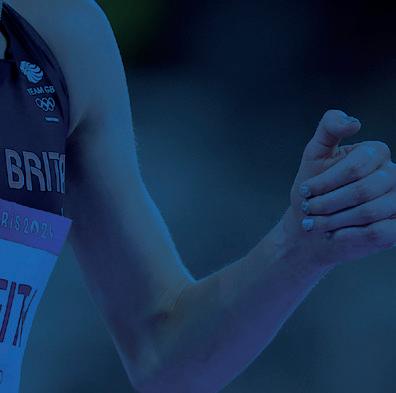

‘I was obviously lacking in races, and it’s just different on the track,’ said the 33-yearold, coached by mum Liz and supported by partner Michael Rimmer.
‘But I’m proud of myself. I made the start line and I nished it. It was a hard slog for me today.
‘Mentally it was tough. With other championships, you can skip it and get your body in the best shape possible. ‘ A few weeks after Paris, Athletics Weekly asked Eilish about the ‘Megan moment’ in the stadium.
‘I didn’t realise the moment went viral as I didn’t have my phone,’ said the four-times Olympian.
gone. I didn’t realise until later what a special moment that was as it was just the two of us experiencing that noise.
‘I just said to Megan that ‘The crowd is cheering for you’ and she replied ‘I felt it I stopped then I wouldn’t be able to call myself an Olympian’.
‘ So she thought she needed to nish the race and I totally respect that because I have the same mentality. It was a special moment and I just wanted to give her a big hug.
‘Sport gives you so many highs and lows and I’m sure Megan will have plenty more moments to come in her career.’
Truly it was a moment which embraced everything that’s good about our sport.
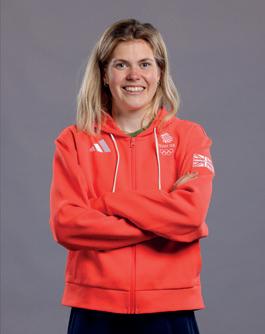
‘It was only when my partner Michael [Rimmer] was saying that the picture was everywhere online that I started to realise the impact.
‘I remember crossing the line and was wondering where and how Megan was. I knew she was having a tough day. I’ve been there plenty of times where I’ve had the dreaded DNF.
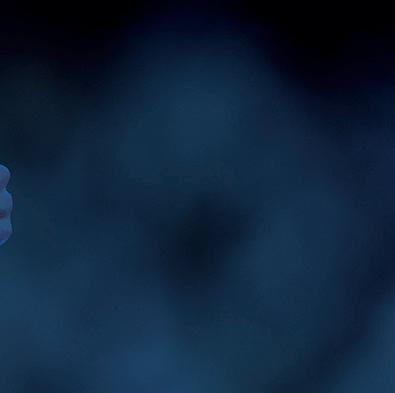

‘So I felt very proud of Megan for not stopping as it’s the Olympics and no one wants to pull out.
‘When she crossed the line she had a sense of relief she’d done it. She asked me ‘Are they cheering for me?’ because the noise of the crowd was just insane. I remember looking round and all the other runners had







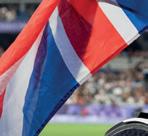
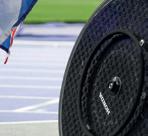
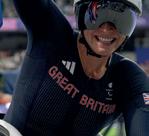
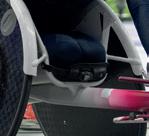






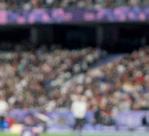


By Peter Jardine
No sooner had Sammi Kinghorn been ringing the Stade de France stadium bell to mark Paralympics gold than her ancé, Callum Aitken, was talking about wedding bells.
Dad Neill and mum Elaine were bursting with pride – and tears – on the Channel Four sofa in a heart-warming moment.
And brother Chris, on his birthday, had ‘one or two alcoholic beveridges’ in mind to mark the celebrations.
Yes, ‘Team Sammi’ was represented in full force that marvellous night in Paris –although the TV sofa to accommodate 29 supporters has yet to be constructed!

The woman of the moment, meanwhile, had dared to visualise such a coronation after two medals at the Tokyo Paralympics and then two more silvers in Paris prior to her stunning T53 100m success.
‘I thought if I was going to win any of these Paris 2024 events, then it would be the 100m nal,’ she said, after victory in the T53 100m nal in a Paralympic Record of 15.64 seconds.
‘Personally, I feel like the 100m is my event. But I have raced Catherine four times over the 100m so far this year and I’d only beaten her once before.
‘Going into the Paris nal I think there was a tenth between us in the world rankings, so I knew it was going to be close.
‘My start was good which I knew it had to


be. I knew my rst push was really good and that gave me a good start.
‘It was weird because normally in a Paralympic nal they would put the fastest three athletes next to each other but there was a gap between me and Catherine (Debrunner), and me and Gao (Fang). I didn’t really see them; I could just about see them in my peripheral.
‘I just told myself to ‘dig in, come on’!
‘When I crossed the line, it was so close I didn’t know if I had won or not.
‘Catherine turned to me and said, ‘you got it’. I wanted to just wait until I saw my name on that screen before I celebrate. I de nitely didn’t know until my name came up on the screen. Oh wow, I’m never going to sleep!
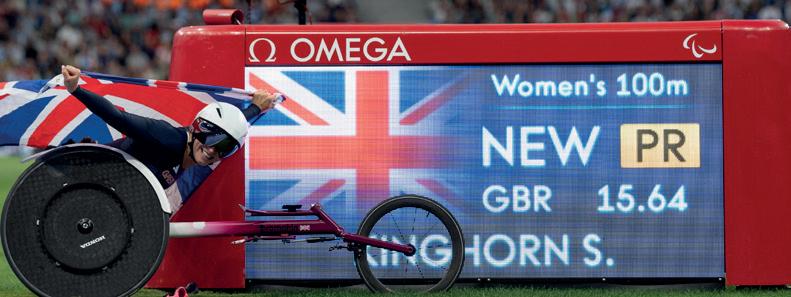

‘When I was getting my medal for the 1500m, I watched my ag go up and I thought, ‘that would be cool if it was in the middle’. Then it was in the middle and I was singing the National Anthem. It is so exciting.’
The excitement wasn’t restricted to trackside. In the stands, ‘Team Sammi’ had gathered among an enthusiastic Paris crowd in a way that was not possible at the Covidrestricted Tokyo version of the Paralympics.
‘I have 29 people here supporting me, posters and all,’ smiled the 28-year-old, who is coached by Rodger Harkins.
‘Family, friends, my partner Callum’s family. I heard all about 2012 and the atmosphere at the Paralympics but didn’t get to experience it, but I think this is the closest I am going to get to a home Paralympic Games. Honestly, the roar on the start line is incredible.’
Back in 2012, in fact, Sammi was racing in the Mini Marathon in London in one of her rst wheelchair events.
And it was brilliant to hear Callum talk about her dedication and the journey towards Paris gold.
‘She’s up really early in the morning and straight into a tough gym session,’ he said. ‘Sammi eats really well and focuses strongly on nutrition. I don’t always eat the same as her and feel guilty! ‘Then she is into another hard training session in the afternoon or at night. She is so committed and dedicated and I am just thrilled for her to win gold.’
Viewers were welling up as well as the family by this stage.
And the wedding bells? Due in January, as Callum revealed. More bling for Scotland’s Paralympic Queen of the Track . .
Sammi Kinghorn’s stunning ve-medal haul at the 2024 Paralympics included a ‘silver streak’ which spanned four nals over six days.
It started on the Sunday evening of the rst weekend of the Games in Paris and concluded just after 8pm on the Friday night.
In the midst of that run came that gold medal moment in the T53 100m nal on the Wednesday evening.
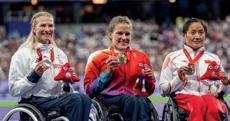
Sammi’s rst thoughts on 800m silver was that her family was there to savour it –which had not been the case when she won a silver and gold in Tokyo – and her closing re ections were on hitting 20 mph in the Universal 4x100m Relay.
Here’s our short summary of the four silver medals . . .
Sunday: T53 Women’s 800m
Swiss athlete Catherine Debrunner won the race in a new Paralympic Record at 1:41.04. Sammi pushed 1:42.96 to nish well clear of the rest in second place.
‘I came fourth in Tokyo, so to get a silver today was incredible,’ said Sammi.
‘Catherine (Debrunner) is amazing. I was staying with her around the bend, but her endurance was a little better. But I put myself out there to see how close I could get.
‘I have worked incredibly hard for this. For me, I won my rst Paralympic medals in Tokyo and it was amazing but, genuinely, if I had come fourth today just the fact that my Mum and Dad and family and friends were there was enough for me.’
Tuesday: T54 Women’s 1500m nal
Debrunner was the Paralympic champion once again – and Sammi came home in 3:16.01 for a superb silver given her strengths have usually been in shorter sprint races.
‘Who would have thought a sprinter was going to win a medal in a 1500m? I certainly did not, I thought I was looking for
fourth, maybe squeeze a third place,’ she grinned.
‘It was all pretty exciting. That noise was absolutely electric, and I am buzzing to come away with a medal in the 1500m.
‘I knew she (Debrunner) was going to go fast, and I just thought ‘I am going to get as close to you as possible’.
Thursday: T53 400m
Debrunner took another gold in a new Paralympic Record of 51.60 and Sammi was almost two seconds back at 53.45 seconds.
At that stage, it made it three silver medals and one gold for the wheelchair racer from the Borders.
‘Four from four, I de nitely cannot complain about that -I am really proud of my performance tonight,’ said Sammi.
‘It is spine-tingling every time you come into this stadium; I am just so glad I get the opportunity to do this.
‘I wanted to go hard for 150m, and that’s what I did. I held her off for a little bit, but her personal best is nearly three seconds quicker than mine.
‘I wanted to make sure my silver was rmly my silver. ‘I didn’t get to sleep till 3am last night.’
Friday: Universal 4x100m Relay
Sammi teamed up with Zac Shaw, Jonnie Peacock and Ali Smith as GB came home in a European Record of 46.01 for silver. The Chinese quartet won in a new World Record.
‘Five from ve medals! I am so chuffed to come through,’ said Sammi.
‘We were hopeful we could get silver. I am pretty chuffed to keep a hold of the Chinese. He’s a 44s man, and I’m a 51s girl, so I am proud of myself.
‘I hit 20mph tonight which is the quickest I’ve been the whole Paralympic Games which is mental on the last night.’





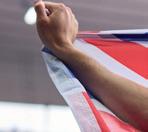




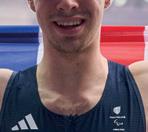
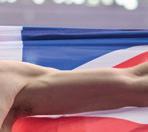




By Peter Jardine
Ben Sandilands was a youngster taking his early steps in our sport a decade ago when ‘Perform When It Counts’ was a key message across Scottish Athletics.
It was so favoured around that era, in fact, that it became the title for the written Strategy of the governing body in Scotland. The ethos of course revolved around athletes – across any discipline, age or event – coming up with their best performance in the big moments in their career. At whatever level that may be.




We’re fairly certain the Sandilands family, although involved in athletics, were probably not too aware although respected coach Steve Doig may well have been preaching the ‘Perform When It Counts’ strategy which at one stage was enshrined across SAL mugs.
No matter the derivation, it is impossible to escape the phrase in any analysis of Ben’s gold medal winning performance in the T20 1500m nal in Paris on September 6.

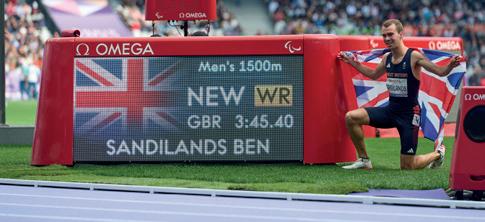
World champion from 2023, the Stade de France nal as seven men lined up was nonetheless his Paralympic debut.
With a PB of 3:47 and up against American favourite and (then) World Record holder Michael Brannigan – at 3:45.50 – the size of the challenge facing the Scot was obvious.



Safe to say Ben once again rose to the task in hand and came up with a quite remarkable race which saw him break that World Record with 3:45.40 and win the title by four seconds.
‘It is an incredible feeling; it has been amazing,’ Ben told Paralympics GB after the Paris nal.
‘A lot of hard work has gone into this. I want to say a big thanks to my family and friends, and my coach (Steve) who have helped me get here.’
In third, Ben was still right on the shoulder of both rivals and what happened next will not be unfamiliar to regulars at Grangemouth, Aberdeen and other Scottish locations in recent years.
Ben has a kick in these situations which can be devastating and somewhere between 250m to go and 150m he had the gold in his pocket. Brannigan was pipped for silver by Portuguese athlete Sandro Baessa.
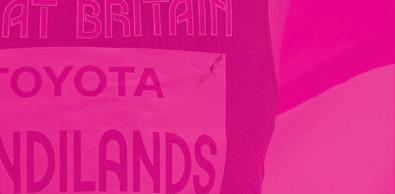
Brannigan set a swift pace and after a rst lap of 61 seconds a sub 3:50 winning time seemed certain.
Ben tracked the American and was well-placed with 600m and then 500m remaining. Italian athlete Dieng then joined













‘I knew I would be fast at the end of the race,’ said the 21-year-old from Kirkcaldy.
‘I knew I had it when I went into the lead. My timing had to be perfect from the 200m mark but I got it right.
‘It was all about going for it and not holding back.
‘I look forward to celebrating with all my family and friends around me.’
Across the athletics community in Scotland, the congratulations began to ood in only moments after the race nished.

Three years ago in Tokyo it was Paralympic gold for Owen Miller – from the same group based in Dunfermline and with Fife AC athletes (as commentators on YouTube highlighted).
Later in the day, radio bulletins across Scotland carried comments from Steve Doig.
‘It is a repeat win for Paralympics GB with Owen having won the T20 1500m gold in Tokyo (in 2021)’ said Steve.
‘So it is also a repeat win for Scotland. But I can’t stop thinking about the fact . . . it is a repeat win for our small training group.’
As well as the group glory, there are wonderful family ties in the Ben story, too.
At the start of the 20th century, his great, great grandfather George Sandilands was an international athlete for Scotland and raced at Ibrox Stadium. Ben’s own grandfather has since passed on a commemorative cap that has become a family heirloom.
The Sandilands clan, it seems, have been performing when it counts for circa 115 years


























MTwo sixth place finishes are source of pride for Mel after hectic week







elanie Woods will take time to re ect on her second Paralympic Games experience in France.
But when the moment comes to assess Paris 2024 and a week of six race across three distances then the over-riding emotion is likely to be a strong sense of pride.
The 30-year-old Scot made the Paralympics GB selection after a series of solid performances at the World Champs in Japan.
Mel then came up with a couple of PB performances; raced in three nals across 800m, 1500m and 400m; and came up with two sixth place nishes.
A hectic week drew to a close in the T54 nal which featured a DQ decision against American Tatyana McFadden.
That moved nishers up a place after Mel had come home in 55.39 seconds.
‘All things considered, I think I should be pretty proud of myself,’ she said, after racing earlier in the day in the heats of the one-lap event.
‘I am a little bit disappointed with the time but realistically I feel like that is a good nish for me. So, when I come away from this, I will look back and think that is quite a respectable nish for me (sixth place in the 400m nal).
‘I think I am in PB shape, so I was ready to take chunks off my time, and that just didn’t come out of me today.
‘That was probably due to a mix of weather conditions and a week’s worth of racing in my arms. ‘
The week had started on the Sunday with two races over 800m – and two excellent PB performances.




Mel clocked 1:45.81 to take third place in her heat in the morning session and then, remarkably, brought that down to 1:43.85 in the nal.
There was something of a blanket nish from silver to sixth come the end of an enthralling two-lap race which had seen Swiss athlete Manuela Schaer deliver the big nish to win in another Paralympic Record.
‘That was pretty incredible,’ said Mel after the 800m nal.
‘It is a huge PB so I have got to be happy with that in the Paralympics. I wanted to be in the mix. I am happy but it is bitter-sweet because when you are in the mix, you always wonder if you have another gear.
‘But I have got to be proud of that.
‘I thought reaching the nal was the hard part, and squeezing in there gave me a whole load of con dence going into it.’
Another day another race saw her come through the 1500m heats on Monday morning.
But the nal in that event was probably the disappointment after nishing in eighth place in 3:23.37.
‘It wasn’t my best race,’ said Mel.
‘The race on Monday was quicker, and I felt more comfortable in the heat, so for me I felt like I was chasing and not nding rhythm today which is frustrating.
‘I was out of lanes in lane two and three and I think the long way around just cost me places. ‘




fights Parkinson’s with positive mind and body

By Katy Barden
Engineer Andy Munro is a lover of spreadsheets, but his continuous research and data collection isn’t linked to his dayjob. It’s far more important than that.
The 52-year-old - a coach at Giffnock North and a committed Munro bagger - was diagnosed with Parkinson’s disease in 2021.
Since then, he’s documented an extensive set of facts, gures, and ‘success story’ case studies aiming to identify what common factors, if any, are shared by those who have lived well with the progressive neurological condition.
‘The one thing that always comes out is exercise and, in particular high intensity exercise, so running - alongside good nutrition - is right up there,’ he says.
‘Parkinson’s will progress at different rates, and with varying symptoms for different people, however, those who seem to be doing ok after many years are the ones who are exercising and eating well.’
Andy rst started to experience symptoms in 2019 when his arm froze as he was trying to whisk an egg. He is not a medical expert, nor does he claim to be, but in a concept which will resonate with most people: he’s simply doing what he can to maximise his quality of life.
Parkinson’s disease is a condition in which parts of the brain become progressively
damaged over many years. The main symptoms of Parkinson’s are an involuntary shaking of particular parts of the body, slow movement, and stiff and in exible muscles. A person with Parkinson’s disease can also experience a wide range of other physical and psychological symptoms.
‘There are a massive number of things you can do yourself to alleviate symptoms and also to slow down progression which the medication doesn’t do, the primary one being exercise,’ he says.
‘There’s also a piece about purpose, social skills and hobbies, and the athletics club gives me a lot of that.
‘I don’t compete as much anymore, but I coach kids and I absolutely love it. When you work full-time it can be quite tiring heading back out to coach at night; but being out there coaching the kids is energising.’
Andy is discouraged by the lack of exerciserelated action taken by those who are either providing a diagnosis of Parkinson’s or being diagnosed themselves. Too much rest - or adopting a sedentary lifestyle - he says, is ‘quite literally the worst thing you can do’.
‘Once you’ve lost mobility it’s hard to get it back again,’ he explains.
‘I ne-tune exercise to a few speci c things that are known to be good.
‘I go to a boxing tness class every week which is intense, but also focuses on hand-eye coordination which is important. I also cycle and do two 5k runs and two circuit classes per week, as well as yoga stretching, meditation and breath work.’
Having always been active – he’s completed a variety of tough events including Barcelona

Marathon and Arran’s Goatfell Hill Race – it makes perfect sense that his priority goal is to complete the Scottish Munros.
‘I’m absolutely determined to nish,’ he says of an epic challenge that has been nearenough a lifetime’s work.
‘When I was diagnosed I had about 100 Munros to go. I’m now down to about 60 to go and obviously I’m trying to get them all done while I still can. Hopefully I’ve still got many more years of hillwalking left but I want to make sure, I want to get them in the bank.
‘I have a wee extra target too; my dad is 85 and although he’s had a few recent health issues, he’s still pretty active. He might be able to join me on the last hill, and that’s what I’m focused on.’
Andy says he’s a little bit less powerful than he was, but his condition hasn’t progressed signi cantly since his diagnosis.
Earlier this year he took part in a group charity walk for Cure Parkinson’s across the North Glen Shiel Ridge, climbing 12 Munros in 36 hours. The related publicity has been hugely positive, resulting in people sharing their own experiences of the condition.
‘I wanted to set an example for my kids and for other people that when something like this comes along, you don’t have to give into it,’ he says.
‘Once your story is out there it’s amazing how many other wee stories it kicks off (about relatives etc). If even one person reads about your story and goes, ‘There’s a bit of hope here, maybe exercise and nutrition can help’ - then that’s brilliant, isn’t it?’’
European Capital of Sport recognises and celebrates the people of Glasgow!
This year, we are Changing Lives through School Sport, Community Sport and Health Sport by supporting ageing, building wellbeing and promoting connections within and between diverse communities. Visit the website to see who's making a difference









By Katy Barden
Glasgow Green looked resplendent in the sunshine as clubs from across Scotland gathered for the 53rd edition of the Allan Scally Memorial Road Relays.
Linlithgow AC’s Malcolm Hughes was feeling pretty good as he prepared for the day. Two weeks earlier the 64-yearold had run Seville Marathon in 3:57:47 and although he was still recovering, he expected to enjoy his outing over 5k.
Around the 1km mark he suffered a cardiac arrest.
Thanks to good fortune and the quick actions of those rst on the scene, Malcolm survived.
Here, alongside fellow runner and paramedic Owen Williams who led the immediate CPR (cardiopulmonary resuscitation) response, he tells his story.

Malcolm’s story
I was doing the second leg of the relay and I started off ne. My legs felt tired, but I thought it was just the marathon after-effects.
When I got to about the 1km stage my legs stopped working. I felt like I was running through treacle. I went over to the side of the path; I thought I sat down, but apparently I kind of collapsed. I wasn’t really sure what was going on.
Someone came up to me, I found out later
it was David Scott (Cumbernauld AAC). He was on his cool-down after running the rst leg and he asked if I was ok. I said, ‘no’. That’s basically the last thing I can remember.
David isn’t a medical person, he thought I’d had some sort of seizure and he put me in the recovery position to start with, but as I understand it a GP who was going past was able to identify it was my heart.
Shortly after that Owen Williams, a paramedic and runner with Lothian RC, was also doing his cool-down. He said he spotted me from 15-20 yards away and he could tell I’d had a cardiac arrest from my colour, so he came over and basically from that point on he orchestrated everything that went on.
Based on what I know now, I blacked out after I’d told David I wasn’t ok. He borrowed a phone and called 999. They said they’d send an ambulance but they also identi ed where the nearest de brillator was - it was about 200m away at the boathouse on the riverbank - so he sprinted off to get that (he got to the de brillator but then realised he needed a code to unlock it, so he had to borrow someone else’s phone to call back to get the code, then he ran back to us).
They tried two or three shocks with the de brillator but they still weren’t getting any response.
Owen and Graham Burrows (a good friend and fellow LAC member who was also running leg two) were doing CPR continuously in between using the de brillator, but it wasn’t until I went into the back of the ambulance - which arrived about 20 minutes after I collapsed - that they managed to get a ‘ utter’. Just some response from the heart, after using a more sophisticated de brillator.
I think they gave me adrenaline too. So that was at least half an hour after I’d collapsed, and for that period of time my heart just wasn’t working.
The fact that they’d managed to use CPR to keep the blood pumping before the

ambulance crew arrived was crucial, but even then there was still a possibility that I could have brain damage if I did survive, but thankfully that’s not the case.
Another of my pals from the running club (Angus Gallie, LAC President) was taking photos and he was given the unfortunate job of phoning my wife.
At that point he really thought I wasn’t going to ‘come back’, so he had to think of a diplomatic way to tell her that they were still working on me but it was very serious and they didn’t know what the outcome would be.
I think the clue came when they took me to hospital. The nearest hospital would have been the Royal (Glasgow Royal In rmary), but apparently those in the know said that if I was taken there it would be a bad sign because it would mean there was nothing more they could do, whereas I was taken to the Golden Jubilee which has a particularly good cardiac unit.
I arrived at the Golden Jubilee and was put in intensive care. The doctors explained to my family that I was in an induced coma and that they would wait until the Sunday morning to see if I was going to come out of it.
If I did regain consciousness, they were unsure of how I might be due to the length of time that I was unresponsive following the arrest. Unknown to me, I started to show
signs of consciousness late on the Saturday evening.
The ICU nurse phoned my wife and apparently I spoke to her just before midnight which I have absolutely no recollection of, so needless to say that was a big relief as they were preparing for the worst really.
When the family came in on the Sunday morning I was apparently sitting up and had already eaten breakfast. It’s all very hazy to me.
I was incredibly fortunate the way it all played out. Ideally you don’t want it to happen at all, but if it’s going to happen it couldn’t have happened at a better place or time.
I do at least 95 percent of my running on my own (in training) but this was during an actual event and there were a lot of other runners around. Even luckier was the fact that Owen is a paramedic and he took control of the situation while David ran for the de brillator.
Also, the fact that Graham was able to help - he had been in the re service and knew all about CPR - along with the GP who just happened to be passing when I collapsed. If I’d been out running on my own I’d have had no chance. Those individuals, well, between them they saved my life.
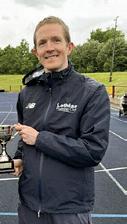
I was just in the right place at the right time really. I was on my cool down; I’d run the rst leg and my wife was out running on the second leg.
It was one of her rst races back after having a baby and she was supposed to be running fourth but she’d been put on the wrong leg. I went off with one of the guys to
do my cool-down and I had the running buggy (and baby Callum) in tow so I could see her on the course.
We got about 1km down onto the Green. I’ve been a paramedic for 15 years and you just quickly recognise what’s happening. Thankfully Ian who was warming down with me was able to look after Callum in the buggy so I could start CPR.










We were really lucky that there were other bystanders who could get involved. There was Malcolm’s friend Graham who’s an ex- reman with CPR training, plus two bystanders, one who was running and another runner who wasn’t involved in the event but was passing by. They were both doctors, so there were three of us there who knew how to do good CPR and that’s the key bit really.
Every minute without CPR reduces the chance of success by about 10 percent. So we quickly got into a good rhythm and we were able to rotate through. That was the bene t of my experience, to coordinate that side of it and to make sure we were doing good CPR.
Someone else was on the phone to the ambulance service and coordinating that response so we could get the ambulance to the right place and so we could use the AED (automated external de brillator) and shock Malcolm.
They’re the two key bits at the heart of the message - knowing how to do CPR, and not being scared around AEDs because they tell you what to do. Good CPR and early de brillation are the essential bits that we know work.
As a paramedic you’re relying on someone else doing CPR before you get there and that makes such a difference; you see that in the outcomes.
It’s just giving people the con dence to know what to do. Some people get in a panic over what’s right - for example do you do rescue



breaths or not? - but ultimately, any CPR is better than none.
Fortunately, the ambulance arrived pretty quickly and the team was able to deliver further shocks and get Malcolm to specialist care. I went into the ambulance initially just to help with the handover and to provide a bit of a link and help get some information across to them.
The big thing we talk about is the ‘chain of survival’; it’s all those little bits that come together, and with Malcolm, it was a great example of it working.
That was what was so brilliant on the day, that people just stepped up and did things. I’m fortunate that it’s what I do for a living and I was in the right place at the right time, but you’ve got people who are massively out of their comfort zones who stopped and did something.
David is a great example. He probably wasn’t sure what was going on but he knew he needed to stop, he knew he needed to call 999 and he knew what he could do in terms of getting that AED.
It would be so easy for people to be overwhelmed or to think, ‘Someone else is dealing with it’ and not to stop, but there was just so much help on the day even before my colleagues in the service arrived.
It was such a great example of teamwork and people getting stuck in, and it made all the difference.

Malcolm’s story (present day, August 2024)
I’m pleased to report that I’ve made good progress with my recovery and return to tness over the last few months, and although I have to accept that I’ll not reach the same level as before (especially while on beta blockers), I know that I’m incredibly fortunate to be able to run and cycle at all!
I’ve now got an implantable cardioverter de brillator (ICD) device tted which is a combination of a pacemaker and a de brillator.
I’ve always had a very low heart rate - my

resting pulse is mid to low 40s, sometimes lower, but doctors don’t seem to think that was the cause - but the ICD stops it going too low. If it goes too high due to ventricular brillation, which is what happened before I had the cardiac arrest, it should re in and return my heart to a normal rhythm, that’s the plan anyway.
My cardiologist gave me the go ahead to very gradually start running and cycling again after an exercise stress test in early May, and I’ve now reached the stage where I’m running Parkruns and cycling 100k without too much dif culty.
I think that the psychological impact of my experience is maybe taking a bit longer to come to terms with, but I still thank my lucky stars every day that I was so fortunate to have such a positive outcome.
One of the things that helped me in the early stages of recovery was when David sent me an annotated screenshot of his Garmin reading after the point he encountered me. He’d marked on it the timeframe of when each thing had happened, or at least the events he was aware of, like calling 999, going to get the de brillator and when the ambulance arrived. I’d been really struggling to get my head around the whole series of events since it happened and that was really helpful. Although I was unconscious at the time, it helped me understand what actually went on.
Since it happened, our club has arranged a rst aid course for club members to learn CPR.
That’s the main takeaway for me - educating people so that they know what they can do to help other runners in the same situation. CPR is a really good starting point. I wouldn’t have survived without it.
For CPR resources:
Save A Life For Scotland:
https://www.savealife.scot/ British Heart Foundation:
https://www.bhf.org.uk/how-you-can-

Linlithgow AC has followed up Malcolm’s story with a rst aid course for members and basic instruction on CPD.
We would urge other clubs to follow suit.
When someone has a cardiac arrest, there are a series of events that need to happen quickly to give them the best chance of survival (the ‘chain of survival’):
• Early recognition and call for help: know when cardiac arrest is happening and call 999
• Early CPR: deliver chest compressions to save the person’s life
• Early de brillation: shock the heart using a de brillator. Every second counts, so this should happen as soon as possible. A quick response gives someone the best chance of survival
Post-resuscitation care: what happens once the person has been resuscitated and is in the care of medical professionals.
The campaign ‘Save a Life for Scotland’ also notes the importance of community readiness (ensuring individuals and their communities are CPR-ready and prepared to act in the event of a cardiac arrest) and aftercare (ensuring all affected parties receive the support they need to recover).
In Scotland, 1 in 10 people who have an out-of-hospital cardiac arrest will survive; however, an individual’s chance of survival decreases by up to 10% for every minute that passes without medical help. In Malcolm’s case, his fellow runners saved his life due to their immediate response to his collapse and their subsequent actions.



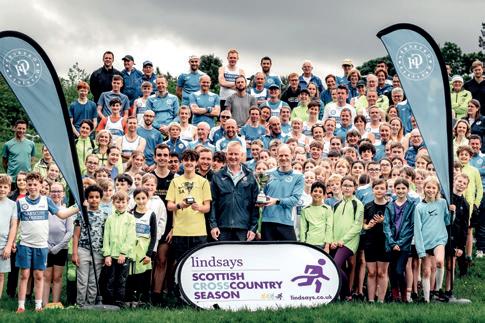
If an endurance feelgood factor has run through athletics in Scotland over the past decade then Garscube Harriers President Daniel Scroop is pretty sure of the source.
The cross country calendar delivers mud and glory in almost equal measure each season and is a fundamental bulwark of the sport in Scotland.
‘I think it is really clear that cross country is at the heart and soul of the world-leading endurance scene we have here,’ said Daniel.
‘It is a privilege for clubs to be part of that and I can say with real certainty that Lindsays Cross Country Season events are real highlights on the calendar both individually and collectively.’
The Garscube President was speaking as his club received the Lindsays Trophy for the second time since it began back in 2105.
There was a difference this year, as we piloted successfully a new three-tier divisional set-up which effectively streams clubs into a league with those with similar nisher numbers at our three main Lindsays events.
Glasgow Uni Hare and Hounds won the Tier Two trophy and Lothian RC collected the Tier Three cup with real enthusiasm. With promotion and relegation, the focus of the Lindsays Trophy is to galvanise clubs to encourage their members to, well, get out and race across the mud and grass.
No fewer than 99 Scottish clubs were represented (by at least one athlete) at the
three major events in the Lindsays Cross Country Season – the Lindsays National Relays, the Lindsays Short Course and the Lindsays National XC.
In addition, a dozen clubs featured more than 100 nishers across those three events.
Giffnock North have been the dominant force in recent years and were very much still in contention ahead of the ‘decider’ at Falkirk.
But Garscube mustered their members superbly again and took the victory by 10 athletes – with 233 nishers from Garscube to 223 from Giffnock.
It’s really quite something to think two clubs supplying more than 450 nishers across just three events in cross country. Edinburgh AC, the rst winners of this Trophy, were third (186 nishers).
Falkirk Victoria Harriers (151) and Cambuslang Harriers (143) completed the top ve.
‘We’re immensely proud to win the Lindsays trophy,’ added President Daniel.
‘The long-standing support for the athletics community in Scotland from Lindsays has been brilliant for clubs like ours. The competition really galvanises us.
‘And, of course, it’s great
for Garscube to be back at the top this year!
‘A personal highlight for me this year was seeing so many beginners don our vest for the rst time.
‘Special thanks to Amy Cromarty, who leads our Beginners and Improvers Group, to coach Robert Cuthbertson, who led the nal charge which secured us the trophy, to head coach John Bell, who inspires us every week with his commitment and love for the sport, and to Alex Chalmers and the junior coaching team for nurturing the next generation.
‘Re ecting on the year and looking at what Scotland’s incredible elite athletes are achieving I think the importance of cross country is clear. It’s great to be part of and long may it continue.’
Glasgow Uni Hares and Hounds won Tier Two with 101 nishers – a brilliant effort from the students. Hunters Bog Trotters were second (80) and Kilmarnock Harriers were third (70).
Lothian RC won Tier Three with 54 nishers – and this was the tightest ‘race’ of the three divisions. Lothian won by a single athlete from Motherwell AC. Moray Road Runners (41) took third.
Ian Beattie, Chief Operating Of cer of Lindsays, was presented the trophies to Garscube and Glasgow Uni.
‘It is fantastic to see the Lindsays Trophy competition thriving,’ said Ian.
‘To have almost 100 clubs taking part re ect well on all involved.
‘Through our support of scottishathletics, we are proud to be helping encourage healthier lives through sport.
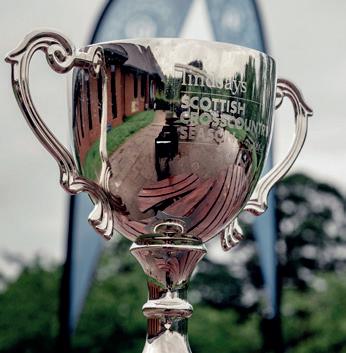


Benefit your club as we invest in the athletics club network
Edinburgh 0131 229 1212
edinburgh@lindsays.co.uk
Glasgow 0141 221 6551


Lindsays is a Scottish firm of experienced lawyers for people and businesses. We are owned and run in Scotland, covering the country from our offices in Edinburgh, Glasgow and Dundee.
scottishathletics club offer
If you use our services, we will give 15% of our final fee for any work undertaken by us back to your club.
Our offer applies to the following services:
• Residential property sales and purchases
• Family law and divorce
• Wills and Powers of Attorney
• Executries
• Employment law services
Please quote Athletics15 when you get in touch
glasgow@lindsays.co.uk
Dundee 01382 224112 dundee@lindsays.co.uk
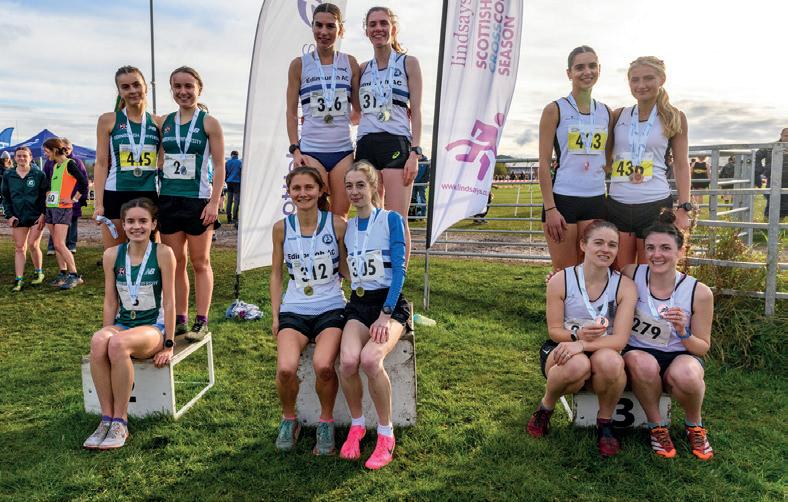


By John Lenehan
Edinburgh Athletic Club women have enjoyed a recent run of great success at competitions across Scotland.
The EAC women have won national-level individual and team medals across all distances and surfaces including on the road, on the track, on the cross-country circuit, and on the trails and hills.
Long-standing records have also fallen as the women’s division at the club has gone from strength to strength – with almost 100 females of all ages now involved.
The 2023-24 Scottish cross country scene was dominated by Edinburgh AC women.

In the Lindsays National XC, Alice Goodall took the win, Nancy Scott was second and Kirsty Walker was fourth, with Beth Ansell, Rose Penfold and Doireann Hughes also putting in strong runs to secure team gold medals. Janet Dunbar won the F50 title, while Sue Ridley picked up F50 bronze
EAC had already delivered at the National Short Course Championships in Lanark. Eloise Walker took the overall win, and Kirsty Walker battled hard for second. With Nancy Scott in fth and Alice Goodall in tenth, the ladies took team gold.
Edinburgh AC’s Kirsty Walker, Nancy Scott and Lauren Stoddart were called up to represent Scotland East in the Inter-District Championships in Renfrew. Kirsty Walker won the race outright, while Nancy was second.
The F50 ladies also took silver at the Scottish Masters’ cross-country championships in Forres, with Sue Ridley, Karen Dobbie and Julie Wilson making up the team.
Moving to the roads, at the National Road Relay Championships in Livingston, Edinburgh AC women took silvers while Sue Ridley, Jenny Maclean and Julie Wilson landed W50 golds.
At the National 10-mile Championships in Strathclyde Park, the trio of Rose Penfold, Doireann Hughes and Isabella Ellwood all ran close to 60 minutes to take team gold.
Edinburgh AC’s ladies also swept to glory at the London Marathon, which doubled as the Scottish marathon championships. Doireann Hughes, Isabella Ellwood and Jayne Nisbet all smashed the three-hour barrier to win the Scottish team title.
The success did not end there:
*Alice Goodall and Janet Dunbar won senior and F50 titles respectively at the Scottish Trail Running Championships.
*Sue Ridley made the trip to the European Masters Mountain Running Championships in Madeira, taking category gold, silver and bronze medals across three mountain races ranging from 5km to 33km.
*Sprinter Stacey Downie won four silver medals at the European Indoors Masters championships in Poland, and Sharyn Ramage also picked up a team bronze medal.
*Finally, the Senior Women set a new Scottish All Comers record and Championship Best time for the 3x800m

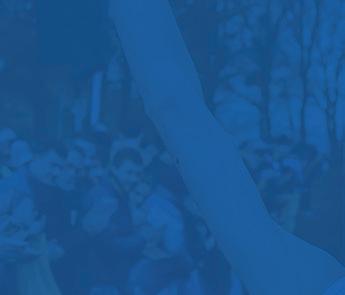
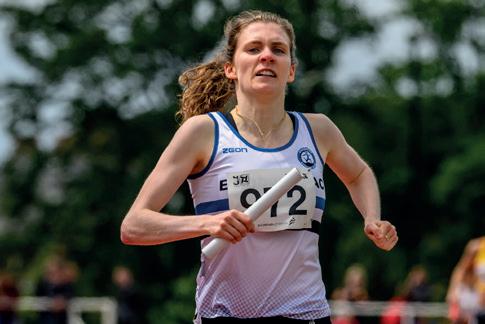
at the Scottish National Track Relay Championships in Ayr. Beth Ansell, Margot Wyrwoll and Kirsty Walker completed the race in 6:43.21, taking almost three seconds off the previous record (which had stood for 32 years).
‘Our middle distance team at Edinburgh AC is amazing,’ said Beth Ansell.
‘There’s excellent communication and camaraderie, and a real desire to come together and bring our best to the different team events.
‘It’s rare to get three Senior Women’s 800m runners in one club, let alone get them all t, healthy and willing to run on the same day.
‘We felt this year that women’s 3x800m record was achievable. A quick bit of maths showed we would each have to run an average of 2:15 per 800m leg. Knowing the girls and knowing their form, we felt well capable of that.
‘Everyone bought into it and committed, and our combined efforts on the day were enough to break a record that had stood

for 32 years. In a sport which is so often focussed on individuals, team success is a welcome and rewarding feeling which shouldn’t be underestimated.’
Margot Wyrwoll re ected on the recordbreaking run: ‘The National Relay Champs are always a fantastic event. Beth found out about the record in advance and told us about it, and she thought we might have a chance to break it.
‘We practised handing over the baton in training. However, as the speed is lower in the 800m than in the sprint relays, the exchange is not so dif cult and a tenth of a second is usually not decisive. I decided to have a safe exchange rather than risking losing the baton.’

Scottish championship events, and we are often able to challenge for national titles.
‘I really value the club and appreciate all the people who support me.’
Ladies team manager Karen Dobbie, herself an excellent runner, commented on the unprecedented successes of the 2023-2024 season.
‘We have some very talented athletes and it’s great to win national level medals,’ said Karen.
‘But success can be measured in many ways. We have a fantastic team spirit and great camaraderie. Everyone plays a part in the team and no matter where we nish, everyone supports each other. There is a very inclusive atmosphere.

Margot went on to praise the club and the people behind the scenes.
‘We are grateful to Bill Walker and Enid Johnstone who supported us on the day and who had arranged everything in the background beforehand.
‘Kirsty and Beth train with coach Sandy Cameron, while I am extremely grateful to my coach Lewis Orr, who provides excellent training programmes for me, and has supported me in various ways since I moved to Scotland a couple of years ago.
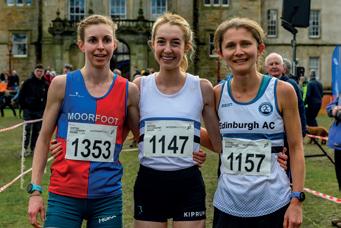
‘We are also supported by amazing coaches who encourage us all to compete.
‘I think the feeling of being part of our running family means that everyone is willing to turn up, whatever the weather, to train and race – not just for themselves but also to represent the club and run as a team.
Long-serving club coach and gurehead Alex MacEwen agreed.
‘I don’t think this current success is a ash in the pan. Edinburgh has a long history of Women’s success, and there are a number of factors that contribute to this.

‘The club has made me feel very welcome. Having so many great runners around makes it possible to have really strong teams for
‘There is a good management and trustee group working tirelessly behind the scenes. We also have great coaches who work with and encourage the youngsters, but also right through to Senior and Masters level, where we promote both high performance and participation.
‘We have developed from elite only to a more all-embracing athletics club. We have a really welcoming and supportive ethos, and our successes motivate us to keep driving the club forwards. Well done to all our ladies on their recent achievements!’
With such a dedicated squad of athletes, coaches and support staff, it seems that the EAC women all set for future success . . . or further information on the club, training sessions, and how to join, visit www. edinburghac.org.uk










Female role models vital in all areas of our sport – as Elaine and Kirsty prove

By Morven Bruce
Our clubs would be nothing without strong leaders pushing them forward.
Elaine Mackay is the rst female President of Shettleston Harriers in 120 years of the club.
She followed in family footsteps, with her father also a previous member of the club
as well as her grandfather, Allan Scally. The club’s annual memorial race in tribute to the latter is now one of the biggest road relay races in GB and it will be the 54th edition in March 2025.
The club celebrated their centenary in 2004 and until then was a male-only club. Elaine was one of the rst women to join 20 years ago when they opened to female athletes for the rst time.
Before this, she was a member of sister club, although very separate, Shettleston Harriers Ladies. She joined age 10 in 1975 and competed for them up to age 25, starting out in shot put and high jump before moving to hurdles, pentathlon and nally middle distance running.
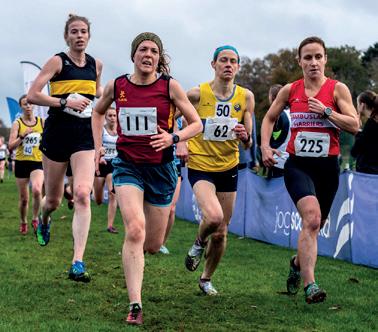
She rst travelled as part of a team aged 13, and has had many team managers over the years who helped her.
This is partly what inspired her to get involved in team managing herself,

and she has gone on to manage teams for Scottish Schools and London Mini Marathon.
‘I love almost all aspects,’ said Elaine.
‘Training and competing but mostly introducing new people to our wonderful sport. Where a child rst running round a track or an adult working towards couch to 5k but most of all team managing.
‘Highlights are so many but travelling with young boys’ team and my son ( and husband and dad team managers) at 14 years old to young athletes nal at Birmingham in 2004 is a great memory and also a trip to Gothenburg.’
Shettleston are now looking ahead to cross country season. The club’s senior ladies represented Great Britain at the European Cross Country Championships for the last two years, so the club are working to encourage all club members to get involved.
Growing up, Elaine’s role model in athletics was her father. Her mother’s role at that time was to wash the kit – back then mums didn’t have time to do these roles while also looking after children. Her mum did eventually take up jogging herself.
‘My role model in my younger years was my father,’ she said.
‘My mum’s role was to wash all our running
Elaine Mackay

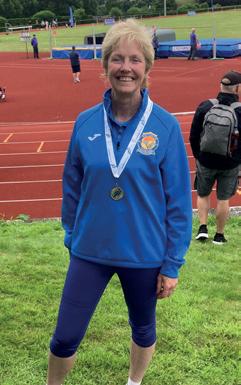
gear and she eventually took up jogging herself. Mums don’t have time to do these roles due to looking after our children.’
Elaine’s career highlight was a PB at the Glasgow half marathon (77:52) and being rst Scottish woman home.
She then had her second child and stepped away from the sport for many years. Elaine returned to running after being encouraged by her daughter.
Speaking about why she thinks it’s important there are female leaders in sport, Elaine said: ‘We need to let youngsters know that there are no limits.
‘We need to have competence then con dence then compete. This applies to running in a race and running a club.
‘Sometimes I don’t have con dence and thankfully other days I do . . . and then I can be vocal.’
Another historic club, Cambuslang Harriers, celebrated their 75th anniversary last year. Having traditionally been a predominantly male club, the women’s section has grown in recent years. Kirsty O’Brien was appointed Club Captain, the rst female in the role.
While we are hopefully past the days of saying ‘trail-blazer’ as we are now fortunate to have had many female leader role models, these appointments are still key representation.
With scottishathletics membership very close to equal male-female, it is important
‘I am currently dealing with the effect of perimenopause, and I have been encouraged and inspired by other women going through the same. Kirsty O’Brien

that the senior positions in clubs more closely re ects that.
Kirsty got into running aged 21, during her year out between undergraduate and postgraduate degrees. Having socialised a lot as a student and not looking after herself the best, she started running and swimming, eventually becoming a triathlete. She joined the club in 2013 on the suggestion of a friend.
Re ecting on being named Club Captain, she said: ‘I am always looking for ways to give back to the sport, and I feel that this has been a great opportunity for me to do so,
‘Over the years I have been in the club I have seen it grow, in terms of membership, aim and ambition. This has been great to witness.’
She also spoke about being inspired by others from within the club, be that winning international, national or district medals, coming back from injury, completing personal challenges, ultra running, or just getting out a few times a week with the club.
However, seeing the growth in the women’s section has been a particular highlight during her time at the club: ‘When I rst started to run with Cambuslang, we would struggle to put one women’s team out at races, ‘Now, we are able to put out multiple, and the women are winning individual and team medals. That has been incredible to watch.’
Looking to the future, the club are looking to bring in a new group of developing runners, following the success of a similar move post-Covid.
Re ecting on why she thinks there are fewer women in leadership positions in sport, she thinks it stems from there being fewer women in sport to begin with. This means you are often going for leadership roles in what is a male dominated environment.
‘I am very lucky at Cambuslang, as they have made this very easy for me. I have always
felt that I am treated as a runner, rather than as a female runner,
‘This is an important distinction, as it meant that that I was more con dent putting my name forward to be captain as I didn’t feel like I was doing it in a predominantly male runner club – I was applying to be a captain of the running club.
Sociological factors, such as caring responsibilities, types of occupation and the socialisation of female gender roles, can also create barriers for women.
‘In sport, the more women involved in both competing and leadership roles, the more it will become the norm and help to break some of these barriers.’
Kirsty believes it’s important that there are female leaders in sport as it is easier to identify people you feel are more like you and have shared experiences.

‘I am in awe of women who have children and come back to compete. I believe women who compete while dealing with their menstrual cycle are complete warriors.
‘I am currently dealing with the effect of perimenopause, and I have been encouraged and inspired by other women going through the same,
‘That is why I think it is important to have female leaders.’
However, Kirsty has also been inspired by some amazing men. When wanting to be more con dent, she nds herself thinking ‘be more Josh Kerr’.
Her coach, physio and massage therapist, all male, have also been fundamental to supporting her training, with all three understanding the importance of treating her as an individual, and some of the challenges female athletes face and how it can affect their training, racing and body.




